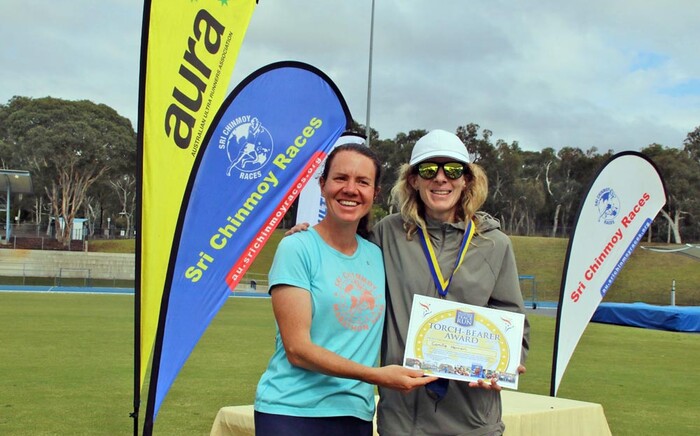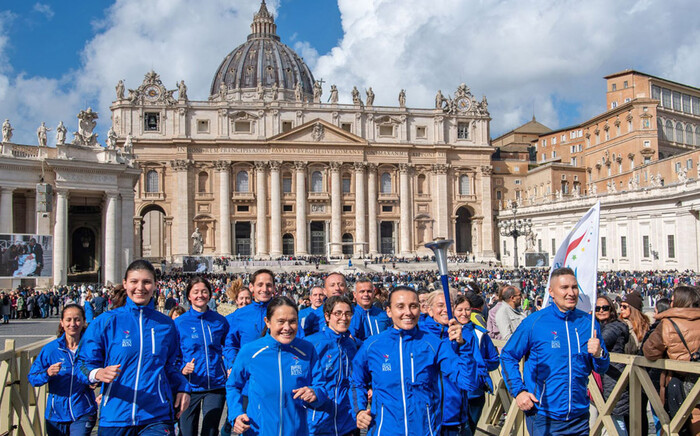
Latest news and features
Recitation of poems from 'The Golden Boat'
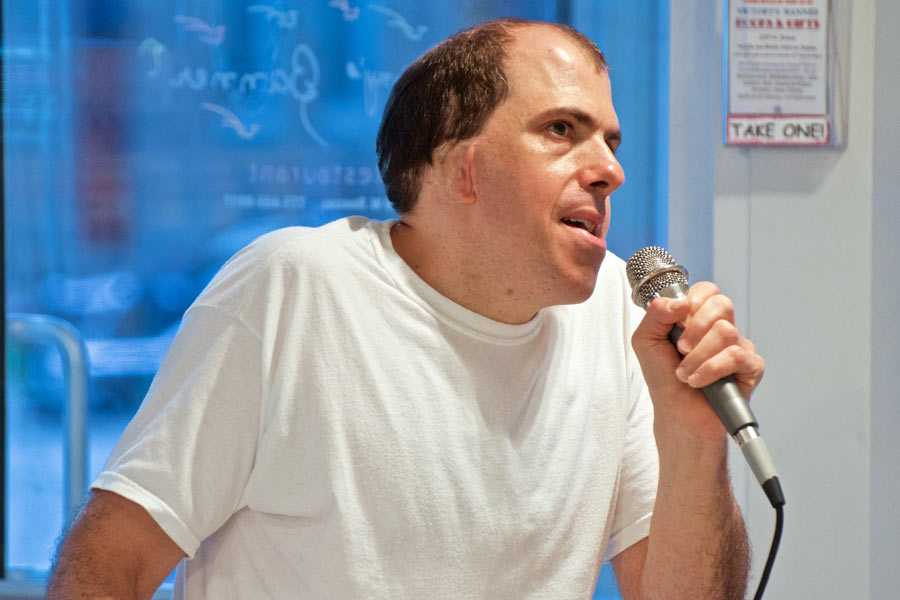
On 21 June, Mahiruha Klein, a student of Sri Chinmoy's from Chicago, recited the entire set of 1,000 poems from The Golden Boat, a series written by Sri Chinmoy in 1974 exploring the multifaceted nature of the spiritual life.
"Poetry is the short-cut to reach the subtle and tangible Goal of goals — Delight infinite. A poem starts in streaming tears and ends in soaring smiles."
Sri Chinmoy 1
During the marathon poetry reading at the Chicago Sri Chinmoy Centre, Mahiruha began at 5 o'clock in the afternoon and finished eight hours later, with just a two-minute break in between each set of 100 poems.
Speaking about the event, Mahiruha says he was physically tired at the end of the marathon poetry session, but also deeply moved by the experience.
He said:
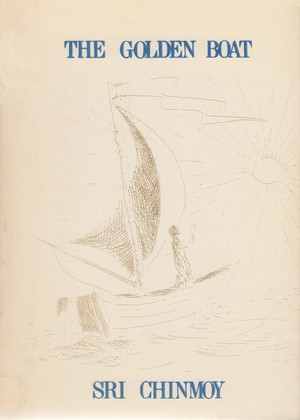 "It took me three years to learn the one thousand poems of the Golden Boat. I practised the poems every day for at least an hour and a half to learn them. I divided the poems and typed them up by themes, like sincerity, gratitude, etc. That made them a lot easier to learn. I further organised them in my mind by the first letter and also by picking a key word from each poem. Then I just practised and practised them until I knew them all by heart.
"It took me three years to learn the one thousand poems of the Golden Boat. I practised the poems every day for at least an hour and a half to learn them. I divided the poems and typed them up by themes, like sincerity, gratitude, etc. That made them a lot easier to learn. I further organised them in my mind by the first letter and also by picking a key word from each poem. Then I just practised and practised them until I knew them all by heart.
At work I’ll often ask customers to give me a topic or key word and I’ll give them a poem from the Golden Boat based on that key word.
For example, one customer asked me for a poem on happiness. So I recited this poem:
Speak without words.
You will be happy.Dedicate without proclaiming.
You will be happy.Love without being loved.
You will be happy.Surrender without being subjugated.
You will be happy.Become without being known,
without being caught,
without being sought.
You will be happy.Sri Chinmoy 2
The customer really enjoyed that poem immensely! These poems have transformed my life. I feel I have grown and changed with these poems.
If I had to pick a poem that I feel expresses the loftiest height, it would be this absolutely immortal gem:
“My heart conceals
The pangs of ages.My heart conceals
The failures of human races.My heart conceals
The indifference of God’s faces.But
My heart feels
Only one thing:
God’s Heaven-free
And
Sky-vast changes.”Sri Chinmoy 3
Previously, Mahiruha had recited all 843 poems from Sri Chinmoy's poetry series Transcendence-Perfection at a recent edition of Challenging Impossibility, an event organised by the Sri Chinmoy Centre where individuals are invited to try and transcend their limitations and achieve some challenging task (and where quite a few Guinness records have been set). These can be sporting, musical, test of skill or – in Mahiruha's case – a test of memory and devotion to poetry.
Mahiruha works at a health food store in Chicago, US.
More of Sri Chinmoy's poetry is available at Sri Chinmoy Poetry.
- 1. From talk 'Poetry-poem-poet' The oneness of the Eastern heart and the Western mind, part 1, Agni Press, 2003
- 2. The Golden Boat, part 12, Agni Press, 1974
- 3. The Golden Boat, part 6, Agni Press, 1974
Start of the 3100 Mile Race 2019
On 16 June 2019, eight intrepid runners took to the start line of the world's longest certified road race - the 23rd edition of the Sri Chinmoy Self-Transcendence 3100 Mile Race. Over the next seven weeks, the runners will aim to complete a daily average of 60 miles or more in order to finish the race within the official time limit of 52 days. The runners have to contend with the hot New York summer, a hard concrete course and the many physical and mental challenges of competing in this epic of self-transcendence.
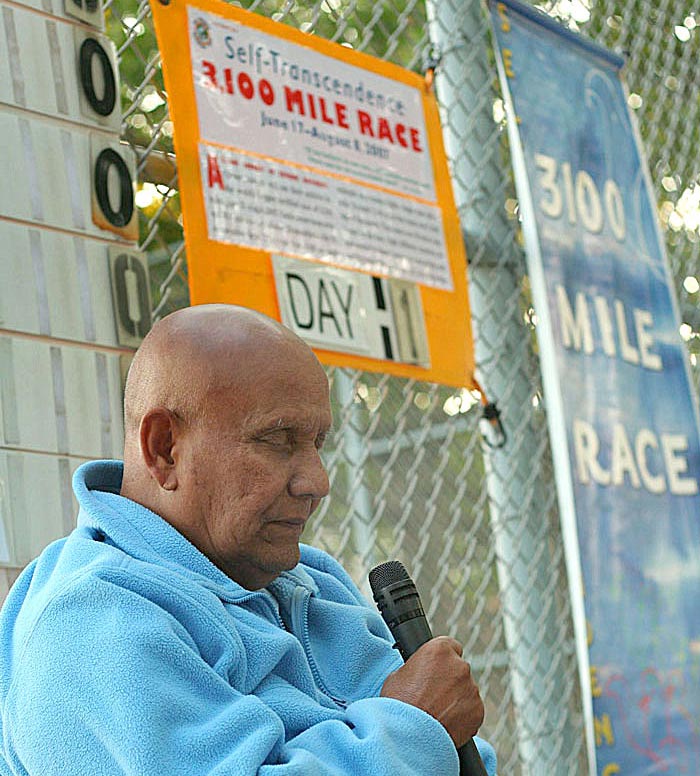
The race was founded by spiritual teacher and ultra-running pioneer Sri Chinmoy, who saw distance running as a vehicle to enable runners to bring to the fore their physical, mental and spiritual capacities to complete this unique challenge.
“He is happy
Because every day he tries
And actually does
A little more than he thinks he can.”– Sri Chinmoy [1]

In this year's race, the runners include Asprihanal Aalto from Finland, an eight-time winner of the race and current course record holder in a time of 40 days+09:06:21. Also returning to the race is three-times winner and 2018 champion Vasu Duzhiy from Russia. Other returning 3100 Mile runners include Smarana Puntigam (Austria), Nirbhasa Magee (Ireland), Ushika Muckenhummer (Austria) and Ananda-Lahari Zuscin (Slovakia).

The only woman running this year is Harita Davies, who returns after a gap of two years, to see if she can improve on her first time finish of 51 days+12:48:14. Todor Dimitrov from Sofia, Bulgaria completes the field and he will be making his first attempt at 3100 Mile Race.

As well as the eight runners, there is a crew of dedicated volunteers who put on the race, including counters, medics, cooks and the organising crew.
Video of day one
To follow the race
- Daily results at 3100 Mile Race
- 3100 Mile home page - with Web Cam and race director's videos.
- Perfection Journey - Daily race blog by Utpal Marshall
- Photos by Jowan
Songs of the Soul tour Germany and Austria
Songs of the Soul, a concert tour dedicated to Sri Chinmoy’s music, travelled through Austria and Germany from 5-10 May. The concerts were organised and performed by Sri Chinmoy’s students from many different countries.
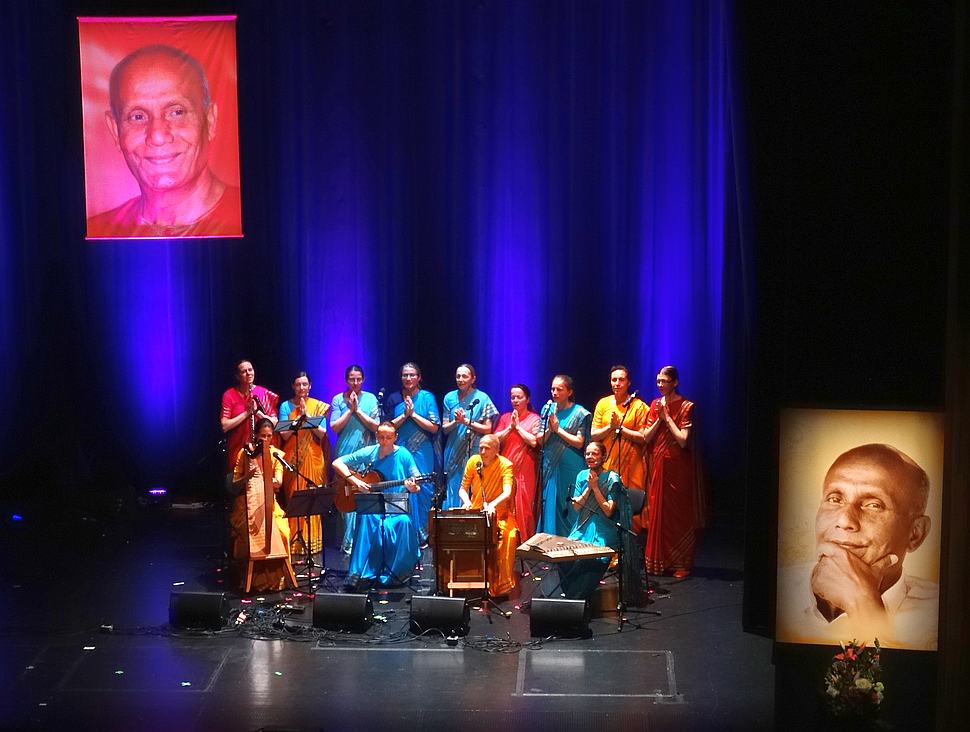
On this particular tour, concerts were given in Graz, Vienna, Munich and Augsburg. A total of 1500 people came to watch the concerts, which are offered free of charge.

Participating groups included Shamita and Dohai (violin and cello), Mandu and Visuddhi (harp and erhu) and Agnikana’s Group (instrumental ensemble). Each group performs the compositions of Sri Chinmoy with their own musical perspective creating a varied and soulful evening of uplifting music.

Sri Chinmoy himself gave close to 800 public concerts during his lifetime. He felt that spiritual music had a unique capacity to bring people into the heart and away from the mind. He believed that by immersing ourselves in music, we can experience a great sense of inner peace and joy.
Music helps the spiritual seeker to go deep within to get the utmost satisfaction from life, from truth, from reality. The spiritual life, in turn, helps music to offer its capacity and its strength, which is the soul’s light, to the world at large.”
Sri Chinmoy

Songs of the Soul is an going series of concerts offered by the Sri Chinmoy Centre since 2008. The aim of the concerts is to share Sri Chinmoy’s musical legacy and give the public an opportunity to experience this unique musical offering.
Related
- Songs of the Soul photos from the recent tour
- More on music by our members
- Quote by Sri Chinmoy taken from the book God the Supreme Musician
Oneness-Dream in England
Recently, the Oneness-Dream international group of male singers toured England to offer several concerts at sacred venues across the country. The group, which includes members from 11 different nationalities, perform exclusively the songs of Sri Chinmoy without any instrumental backing. The group was formed in 2011; they seek to offer seekers the unique experience of Sri Chinmoy's songs in a meditative and prayerful environment.
Listen to Oneness-Dream
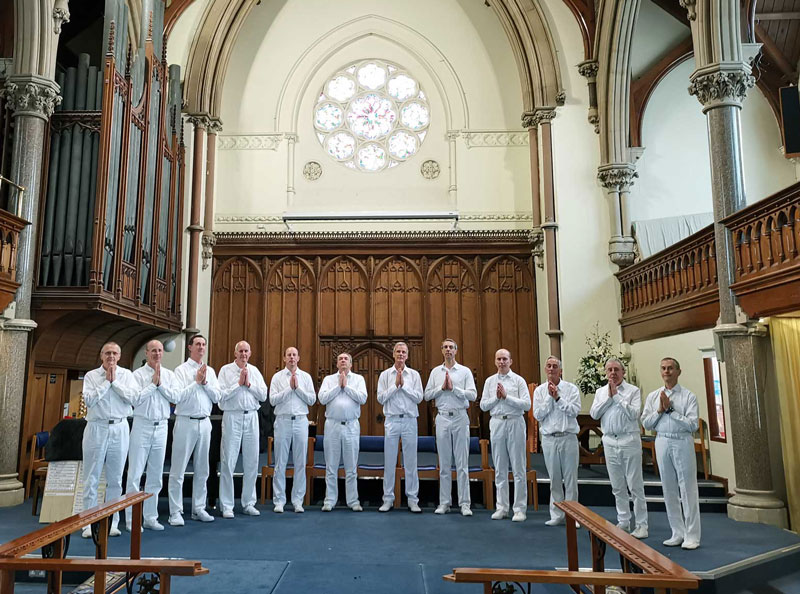
Highlights of the tour included a performance at Kings College, Cambridge directly after Evenson, and performances at Ely Cathedral and Wells Cathedral. The songs of Sri Chinmoy touched many in the audiences who were moved by the simplicity and soulfulness of the singing.
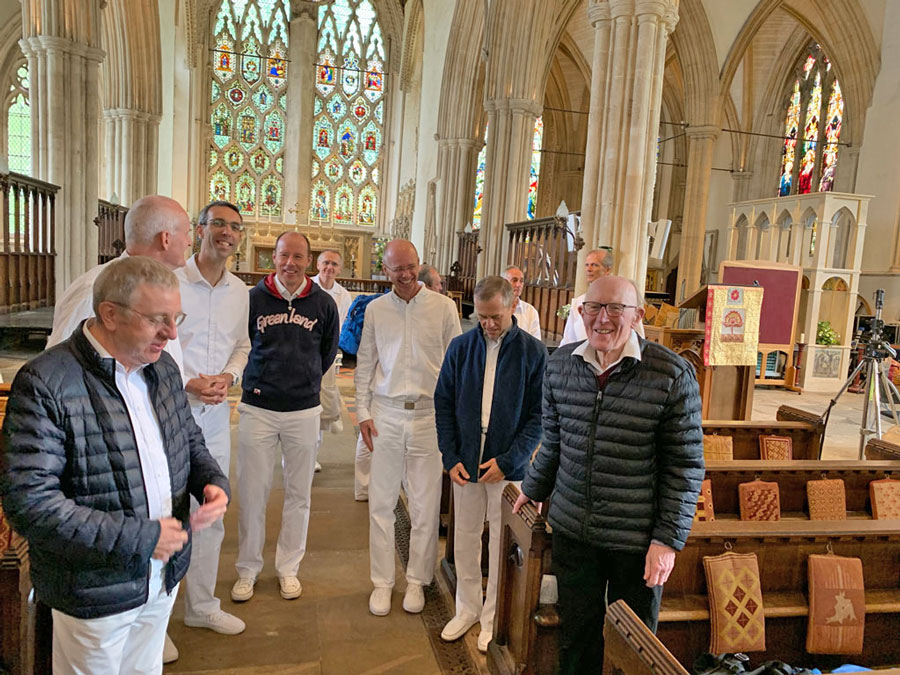
At Dorchester Abbey, near Oxford, the concert was attended by the Rev. Marcus Braybrooke, a long-time friend of Sri Chinmoy who shared his dream of interfaith oneness. In 2003, Sri Chinmoy honoured him with the Lifting up the World with a Oneness-Heart award at Lady Margaret Hall, Oxford University. After the concert, he generously appreciated the singers for their soulful songs and for continuing Sri Chinmoy's work of offering peace and goodwill around the world.
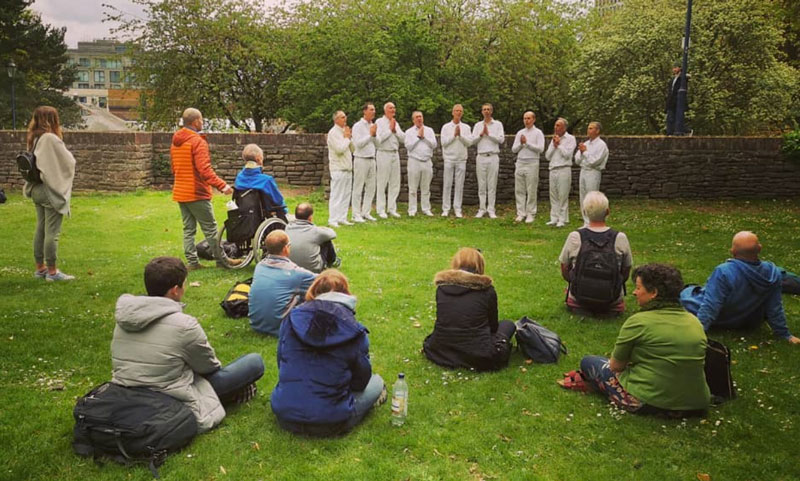
Towards the end of the tour, the group visited Bristol where they performed in the open air and recorded several songs for a future album.
Related
- Oneness-Dream in Scotland - album at Radio Sri Chinmoy
Photos top and bottom: Kedar
3100 film events around the world
3100: Run and Become was released last year in the US and since then has been opening in countries around the world. The documentary explores long-distance running in cultures around the world, including the Sri Chinmoy Self-Transcendence 3100 Mile Race. Here are just a few of the things that have been happening around the world:
United States
There have been screenings of the documentary all over the US during 2018 and 2019. Scott Fauble, a top American marathoner (2:09), came to a screening in Flagstaff in September; he published a top-selling diary of his fall training season and mentioned that watching the documentary made his workouts seem a lot easier! Chris McDougall, author of the famous ultrarunning book Born to Run, hosted a screening of the movie in New York in February and commented that the film was one of the best running films he had seen. Dr. Dan Lieberman, a subject of Born to Run and one of the world's pre-eminent evolutationary biologists, hosted a screening at Harvard University the weekend of the Boston Marathon. He absolutely loved the film and how it linked running to prayer, remarking how there also exists tribal communities in India who run long distances with that very attitude.
The film is available now to watch online in the US and Canada.
Watch on: iTunes • Google Play • Amazon
Bulgaria
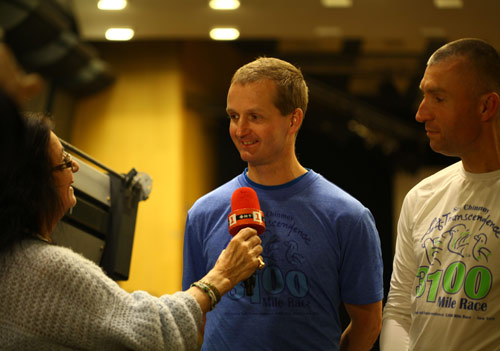
In January, Sofia was the first European capital to present the premier, which was screened in the National Home of Culture. The premier was attended by Ashprihanal Aalto, the men's record holder and Ushika Muckenhummer, who competed in the race last year for the first time. They were joined by some of Bulgaria's best ultrarunners: Hristo Tsvetkov, 12 and 24 hour Bulgarian recordholder; Krasse Georgiev, the only Bulgarian to finish Badwater; Todor Dimitrov “El Capitan” national record holder for the 6-day race. After the movie, Krasse Georgiev commented “While I was watching the movie I thought to myself: 'What I do is a summer vacation in comparison with what these boys do.'" The film has also been invited to screen in the International Red Cross Film Festival in Varna this summer; the festival director, Bozhidar Manov had some very nice things to say about the film. The premiere was broadcast on the national TV station, along with an interview with Ashprihanal and Ushika.
Bali
In February, the Indonesian premiere took place in Denpasar. The film's director, Sanjay Rawal, was on hand to answer questions, along with many 3100 mile runners, including the women's record holder, Kaneenika Janakova from Slovakia.
New book: plays based on stories by Sri Chinmoy
 This month marks the release of a new book of ten plays by Sumangali Morhall, based on stories by Sri Chinmoy. Each play contains between one and thirteen stories, set to rhyming verse.
This month marks the release of a new book of ten plays by Sumangali Morhall, based on stories by Sri Chinmoy. Each play contains between one and thirteen stories, set to rhyming verse.
This volume has since been accepted by the library of Harvard Divinity School.
Sumangali comes from York, UK and this is her second book, her first being Auspicious Good Fortune, an account of how she came to the spiritual life.
In the introduction to the book, Sumangali explains how she began writing these plays:
"These rhyming plays began on a Christmas Trip with Sri Chinmoy in China, December 2004. On our winter retreats, as well as meditating with Sri Chinmoy in person, we had the privilege of immersing ourselves in his new creations: songs, prayers, aphorisms, stories and artwork. In the evenings it usually fell to us, his disciples, to entertain one another on stage. Much of the programme consisted of plays based on the Master’s stories – some of which are tales retold from Indian folklore, others anecdotes from Sri Chinmoy’s own experience, others born of his own creative imagination, and many seemingly from delightful worlds between.

I rarely involved myself in plays up until then. I was – and still am – terrible at acting. My self-consciousness and inability to handle pressure led to a chaos of forgetfulness on stage. It saddened me not to contribute though, so that year in China I decided to take a risk and play to my strengths. I like to write. I could reliably read something out from paper. I could draw some faces on card, cut out holes for eyes, and tie them back as make-shift masks. The characters would mime, while others – including myself – would read their lines into a microphone off-stage. Hence everyone was hiding, which suited me well. The actors did not need to memorise their lines verbatim, which suited them too.
I was quite sure it would end in disaster even before it began, but to my surprise there were no accidents, even amongst the short-sighted, and any confusion was only a minor distraction. Sri Chinmoy was attentive, and I dare say even seemed quite pleased, which astonished me no end. So a new tradition began, and has continued beyond the Master’s passing, as the Sri Chinmoy Centre meets each year for Christmas Trips."

While striving to preserve the original teachings, the plays are embellished – often in a humorous way – and sometimes carry a modern interpretation.
As the actors mime behind masks while the poetry is recited off-stage, the plays perhaps combine two ancient spiritual traditions – rendering spiritual stories into verse, and masked performances.
The Ramayana, one of the great epics of the Hindu tradition, is known as the adi-kavya, or first poem. Great spiritual writings – for example, the Mahabharata and the Christian Bible – have been wrought into poetry through the ages, as an act of spiritual discipline and devotion. Sri Chinmoy himself set to verse the works of Sri Aurobindo, his own Guru - at the age of fifteen, he created 188 lines of Bengali verse from Sri Aurobindo's short story Ksharma Adarsha. In 1956 he translated it into 107 lines of English iambic pentameter verse. He set the Bengali poem to music in 2002, and it remains his longest song.
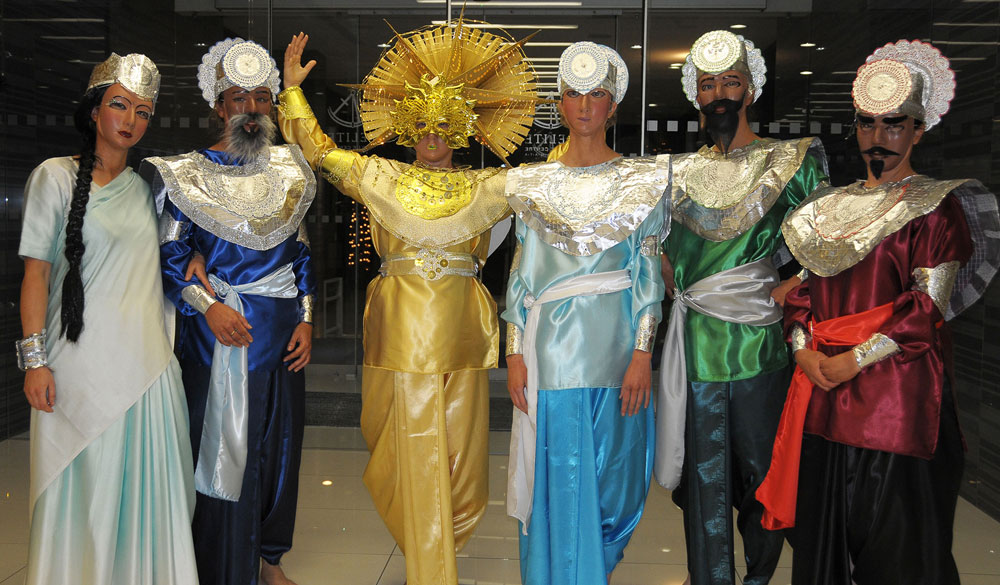
The use of masks in spiritual ceremonies dates back thousands of years, and later extended to various theatrical traditions throughout the world. In Asian countries such as India and Indonesia they are often used in elaborate performances of the Ramayana and Mahabharata. In the Middle East, folk theatre includes masked acting and puppetry, which has been a part of religious occasions for centuries. Actors in Ancient Greece wore masks, especially when depicting a powerful character such as a god. In Japan, Noh theatre evolved from more ancient forms of masked acting.
Related
- Books by Sri Chinmoy and students of Sri Chinmoy
- Auspicious Good Fortune by Sumangali Morhall
Book available for purchase
- Plays based on stories by Sri Chinmoy at Amazon
The spiritual value of running marathons
Sri Chinmoy encouraged running as a complement to meditation and the spiritual life. He saw how it could help people transcend themselves, both inwardly and outwardly. Running helps both our physical health, which is needed to meditate well, and also helps to bring forward qualities such as concentration, discipline and a quiet mind.
Running is a symbolic sport in the sense that it reminds us of spiritual seekers continuously running towards the goal; it resembles the seekers running inwardly to achieve the ultimate goal in meditation.
Sri Chinmoy

Many members of the Sri Chinmoy Centre run as part of their daily spiritual practice and often complete one or more marathons a year - the gold standard of distance running. They also organise marathons and other distance events for the general public as part of the Sri Chinmoy Marathon Team. Sri Chinmoy events are well known for creating a friendly atmosphere and seeking to maintain high standards of service to runners.
Sri Chinmoy himself took up long-distance running at the age of 47, showing that age need not be a barrier to running and physical fitness. He completed his first marathon on 3 March 1979 in Chico, California in a time of 4:31:34, and went on to do 21 more marathons and 5 ultras. This weekend, members of the Sri Chinmoy Centre around the world completed marathons to mark the 40th anniversary of Sri Chinmoy's first marathon run.
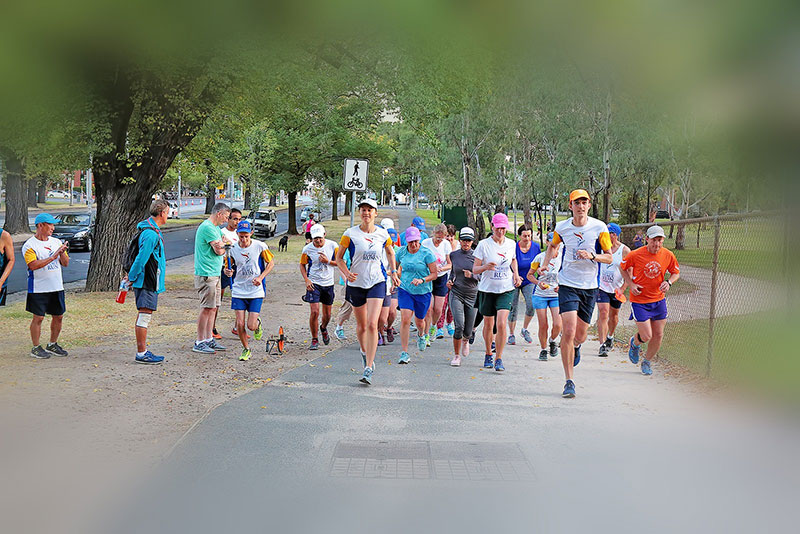
In Melbourne, Australia, around 50 students of Sri Chinmoy took part in a marathon event. They were joined by an international team of runners from the Sri Chinmoy Oneness-Home Peace Run who had recently run from Brisbane to Melbourne as part of a global torch relay which began in February and will run until November, visiting all the countries in the Southern Hemisphere along the way.
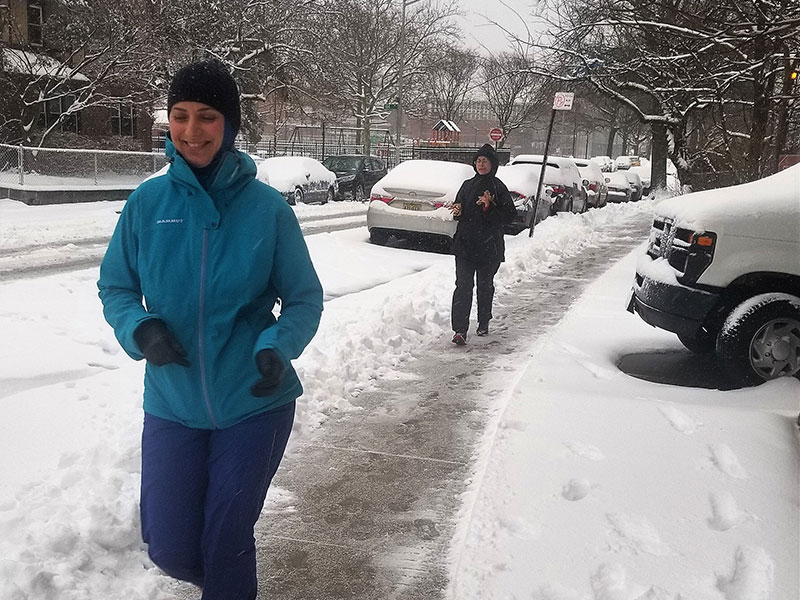
In Chico, California, 70 members of the Sri Chinmoy Centre took part in celebrations to mark the anniversary. The Chico marathon - called the Bidwell Classic - is still run as an event 40 years later, albeit over the half-marathon distance. Some runners then proceeded to do the half-marathon a second time to complete the full marathon distance.
In addition, marathon events were held by Sri Chinmoy Centres all over the world, including in Augsburg (Germany), Bristol (UK), Dublin (Ireland), Zlin (Czech Republic), New York (US), and Sao Paulo (Brazil)
Sri Chinmoy on marathons
Long-distance running gives us a real feeling of accomplishment. We can run 100 metres forty times during the year and not feel the same sense of accomplishment as when we run one marathon. But speed and endurance are both important, especially in the spiritual life. If one has only speed, then one cannot ultimately succeed; we need endurance because the goal is quite far. Again, if one has only stamina and no speed, then it will take forever to reach the goal. Only if someone has both qualities will he be able to make very good progress in his spiritual life and achieve something really great in life.
Sri Chinmoy
How running and meditation go together
More on our other sites
- Video: Samunnati on meditation and running - Samunnati Lehonkova is a marathon runner who took up running at an early age after becoming a disciple of Sri Chinmoy, and ended up competing in the Olympics in 2016.
- Seven Steps to a Successful Marathon Arpan DeAngelo has been a student of Sri Chinmoy since the early 1970s; he has completed over 300 marathons.
- Sri Chinmoy's Philosophy on Running - at the Sri Chinmoy Marathon Team website
Quotes by Sri Chinmoy are taken from his book The outer running and the inner running.
Sri Chinmoy's esraj anniversary
Sri Chinmoy began playing the esraj on this date - 17 February - in 1976. Despite being fluent in many instruments, the esraj soon became Sri Chinmoy's favourite musical instrument, and he would frequently play specially constructed esraj at his Peace Concerts offered around the world. Quite often Sri Chinmoy would give an esraj concert on 17 February to mark the date when he began to play.
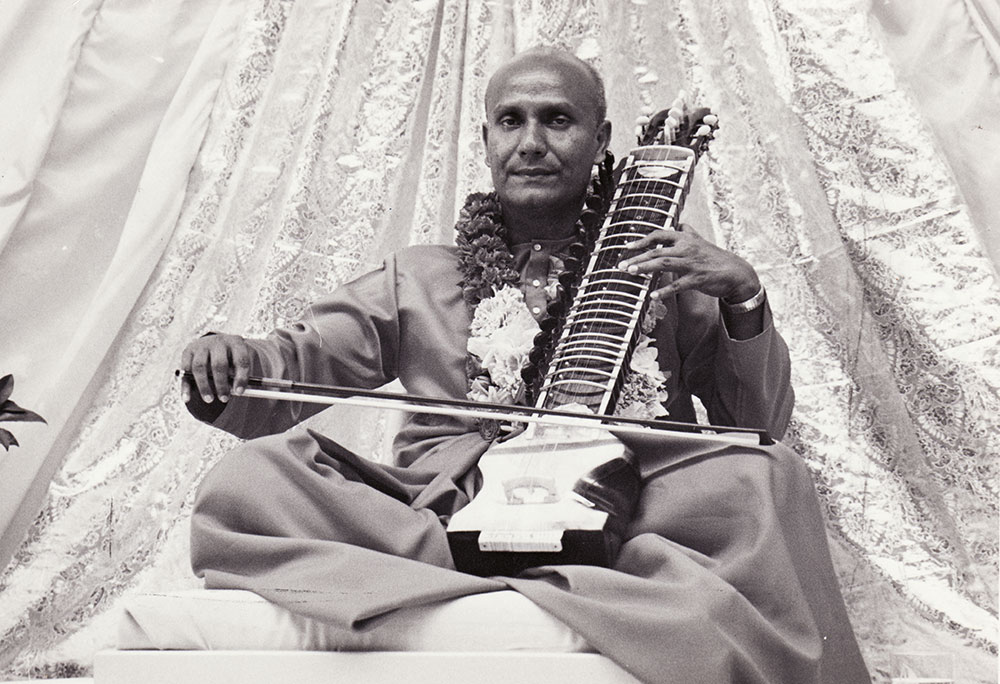
The esraj, an Indian stringed instrument played with a bow, emerged in India over 500 years ago during the time of the Moghul Emperors. Compared to other Indian instruments such as the sitar or tabla, the instrument is relatively unknown, but can create a haunting, reverberating tone - evocative of deeper realities.
Sri Chinmoy was rare in playing the esraj solo, unaccompanied by any other instrument. He would play his own songs or improvised extemporaneously. A few of his esraj instruments were hand-constructed by his students, who sought to create an ever deeper and richer sound. When he performed on one particular esraj for Maestro Ravi Shankar during a private performance in New York October 10th, 2002, the great musician was deeply moved by the music and he gave the instrument the name "Chinmoy Beena".
I pray, I meditate, I contemplate while I am playing. I try to be in close communion with my Inner Pilot, who is the Supreme Musician. And according to my capacity of receptivity, I try to offer His Light and Peace to the world through my music. So when I play, the esraj is not the real instrument; it is I who am the instrument.
Sri Chinmoy
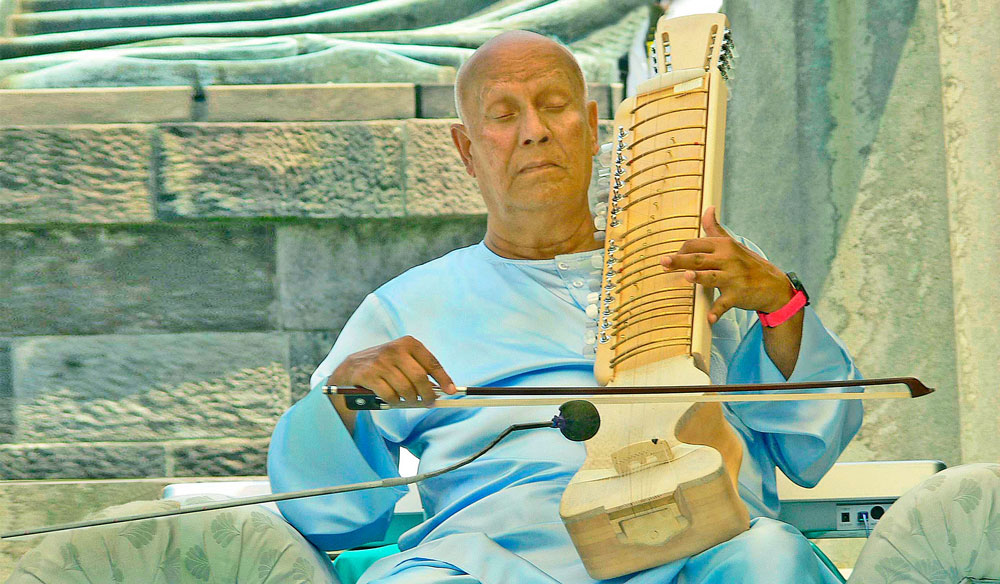
Related
- More on Sri Chinmoy's music at Sri Chinmoy Centre
- The esraj - Sri Chinmoy's favourite instrument at Radio Sri Chinmoy
Source of quote
Peace Run begins its journey around the world
Recently, the Sri Chinmoy Oneness-Home Peace Run started a new journey, in which it will visit all 44 countries in the southern hemisphere. It will be the first time the international team of runners will encircle the globe in a single Peace Run.
During its journey, the Peace Run gives countless people the opportunity to join in with the spirit of the run by holding the Peace Torch and spread a message of peace, friendship and harmony.
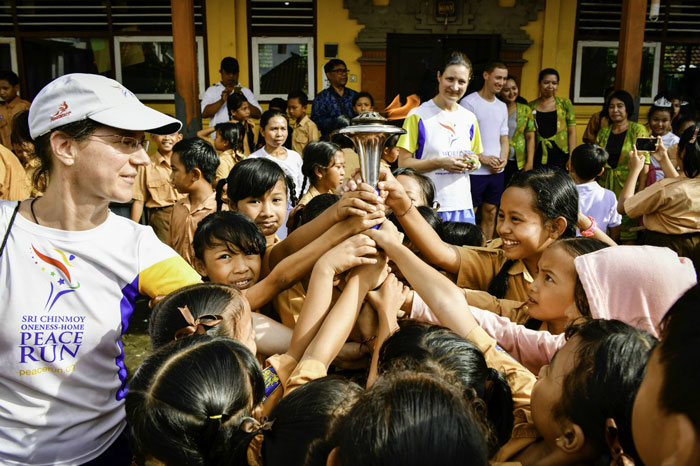
This momentous Peace Run began in Bali on the 1st of February and is now in Australia, having visited Vanuatu, Timor Leste and Papua New Guinea. The entire journey will take the best part of a year and is scheduled to finish in Bali in November 2019.

The route will take in Australia, New Zealand, the Pacific islands, South America, Southern Africa and islands in the Indian Ocean.

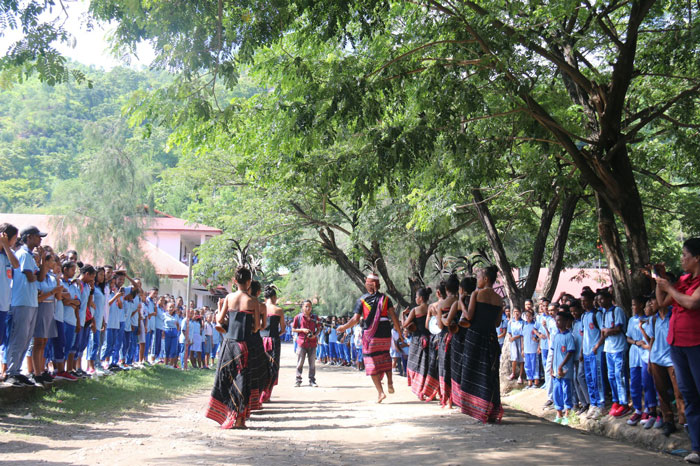
The Peace Run was founded by the late peace visionary Sri Chinmoy in a spirit of love, harmony and oneness. This spirit permeates the relay and touches the hearts of all those who participate. An athlete, philosopher, artist, musician and poet, Sri Chinmoy dedicated his life to advancing the ideals of world friendship and oneness.
“We do not need
Heaven-born saints
But just earth-born seekers
Who believe in peace
And want to live in peace.”Sri Chinmoy 1
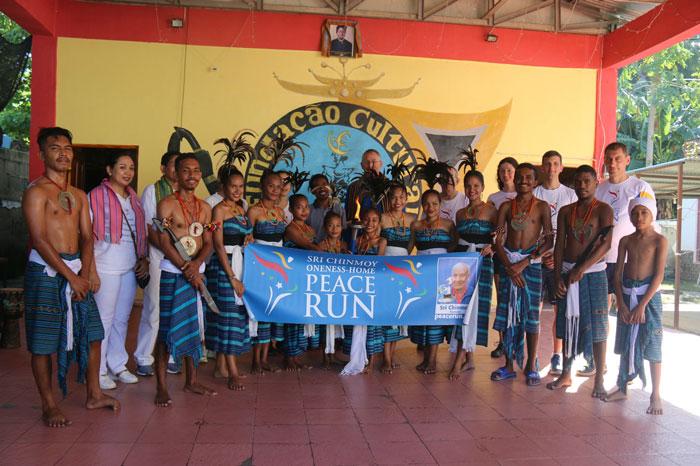
Related
Concert tribute to 100th Anniversary of Czechoslovakia
To mark the 100th Anniversary of the foundation of Czechoslovakia in 1918, members of the Sri Chinmoy Centre offered three special concerts dedicated to the friendship between the Czech and Slovak Republics.

The tour began with a concert in Zlin on 15th November. The second concert was held at Pavol Országh Hviezdoslav Theatre in Bratislava on 16th November. The following day on the 17th November, the final concert was offered at Dvorak Hall, Rudolfinum in Prague. The 17th of November is also a significant date in Czech/Slovak history as it marks the 'Velvet Revolution' and the end of Communist rule.
The concerts contained performances from four different musical groups, along with a video projection of one of Sri Chinmoy's own Peace Concerts. The performers included Alap and Lucas on flute and duduk; the sitar-tabla-tanpura trio of Kanala, Sadananda and Ushika; and Shamita and Bhoiravi from Austria on strings. The finale was the international Sahadeva Ensemble, with over 60 members.

The music performed was composed by Sri Chinmoy and included a rendition of Sri Chinmoy's tribute to Czechoslovakia - a song which Sri Chinmoy wrote in 1990 during his visit. This particular song was first performed in New York, 1996 in the presence of Karel Kovan and Petr Tomek, the then-ambassadors of the Czech Republic and Slovakia in the United Nations.
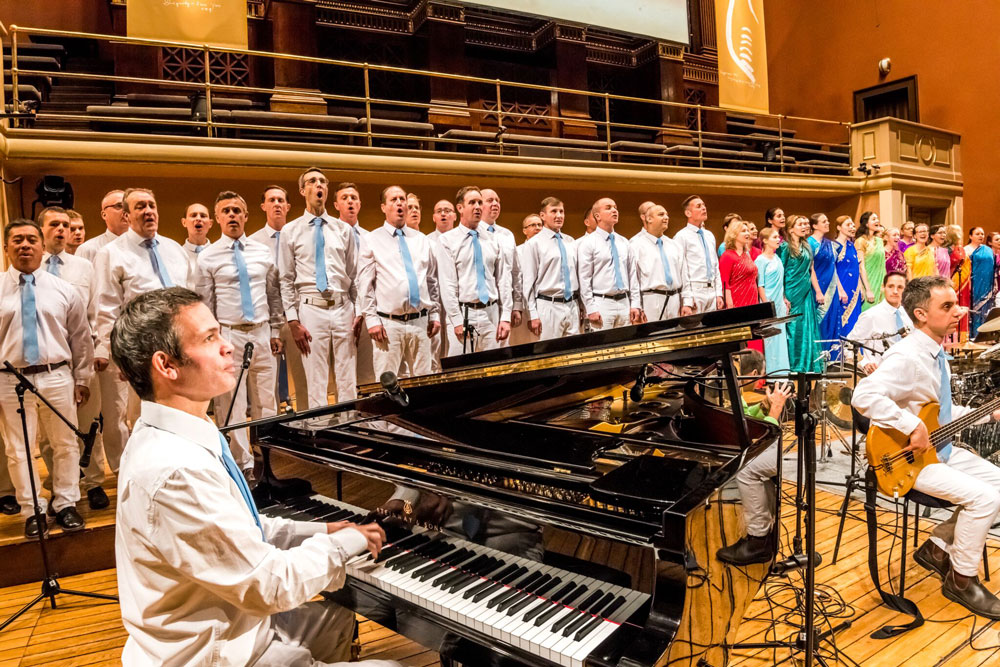
The concert venues were all filled to capacity and the audience expressed their appreciation for a memorable musical experience. The performers came from many different Sri Chinmoy Centres around the world and arrived in the Czech Republic for several days of intense practice before performing in the concerts.
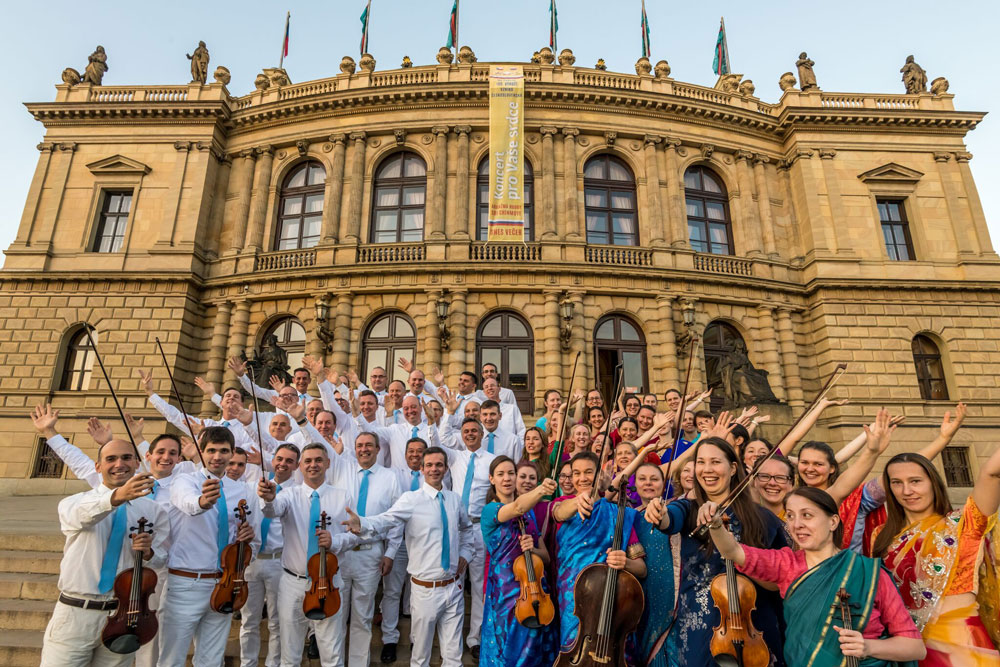
The concert series was given the title Concert for your Heart, in recogition of Sri Chinmoy's approach to music and spirituality, which is to focus on the spiritual heart.
Only the music
Of the aspiration-heart
Can unlock the door
Of Heaven.Sri Chinmoy 1
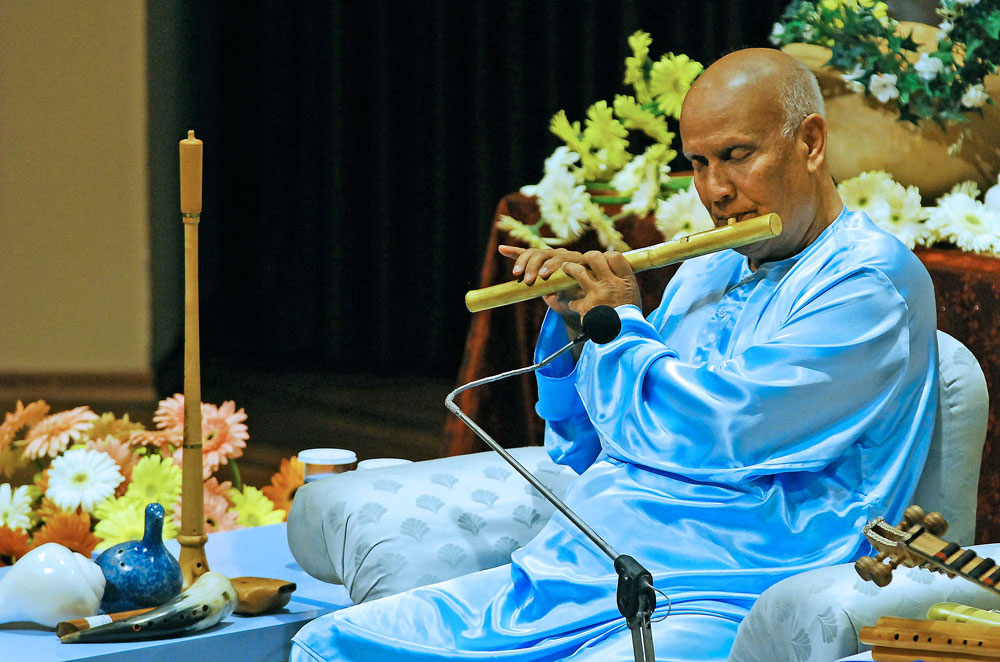
During his lifetime, Sri Chinmoy offered seven major Peace Concerts in Czech and Slovakia. This included a concert for 15,000 people in Prague during 1995. Sri Chinmoy felt that through prayerful music, he could offer seekers the opportunity for a meditative experience.
- Photos by Apaguha Vesely
- 1. Sri Chinmoy, Seventy-Seven Thousand Service-Trees, part 1, Agni Press, 1998
Parliament of World Religions 2018 in Canada
The Parliament of the World's Religions began in 1893 in Chicago, as an initiative to bring the different religions and spiritual paths together. This gathering became famous for announcing the great Indian spiritual figure Swami Vivekananda to the world, and in doing so became a landmark in introducing Eastern spirituality to the West. A century later in 1993, the Parliament was once again reconvened in Chicago, and Sri Chinmoy was asked to give the opening meditation.
Since 1993, the Parliament has been held in multiple locations around the world. This year Toronto in Canada was the host, and members of the Sri Chinmoy Centre joined with members of many faiths and spiritual paths around the world in offering concerts, meditation events and talks.

Sri Chinmoy often wrote and spoke on the ideal of interfaith harmony, out of his inner experience that there are many different paths all leading to the same goal.
"I fully agree that all religions lead to one truth, the Absolute truth. There is One truth. There is only one Goal, but there are various paths. Each religion is right in its own way."
Sri Chinmoy 1
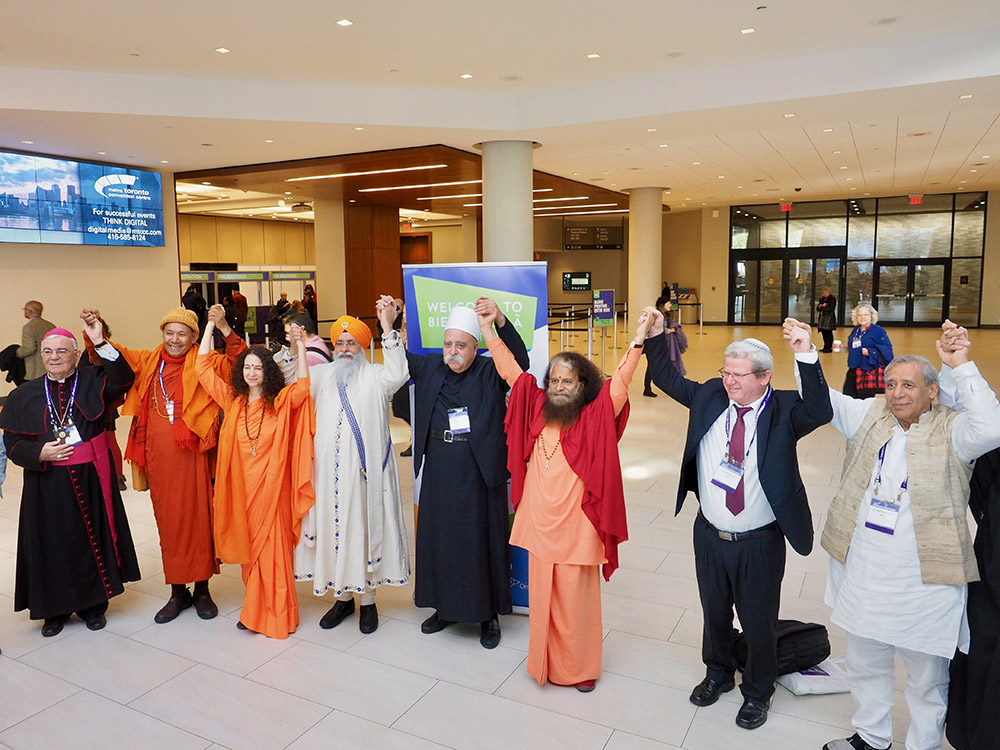
A popular offering was a heart-centred meditation led by university professor Utsahi St-Amand, from the Sri Chinmoy Centre in Ottawa. Meditation is a powerful way to feel the spirit of interfaith harmony because it connects on a deeper level than the intellectual mind. Members of the Sri Chinmoy also offered talks and presentations on different aspects of Sri Chinmoy's teachings.

Throughout the Parliament, our members shared the message of peace with participants in a simple and moving way, by inviting them to hold the Peace Torch and make a silent prayer for peace. The Peace Torch has been carried throughout the world in relay style by members of the Sri Chinmoy Oneness-Home Peace Run, a global relay run which brings the torch and its message to millions of people and invites them to add their wishes for peace.
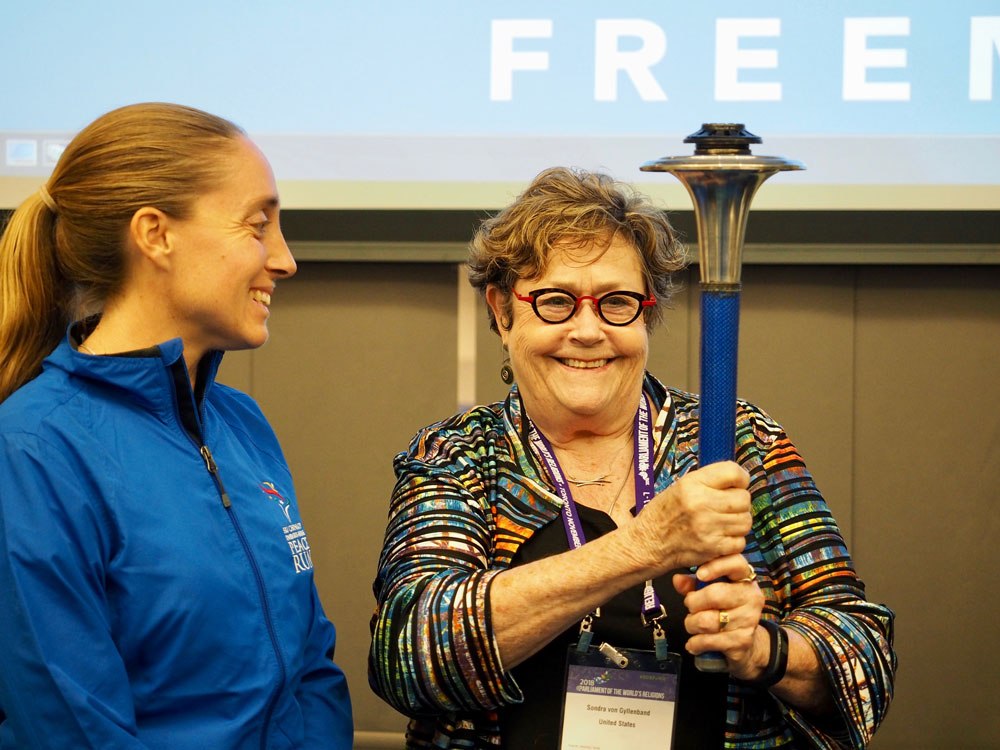
This silent wish for peace is very much in line with the opening meditation that Sri Chinmoy gave in 1993; he would again give the opening meditation at the Parliament in Barcelona in 2004.
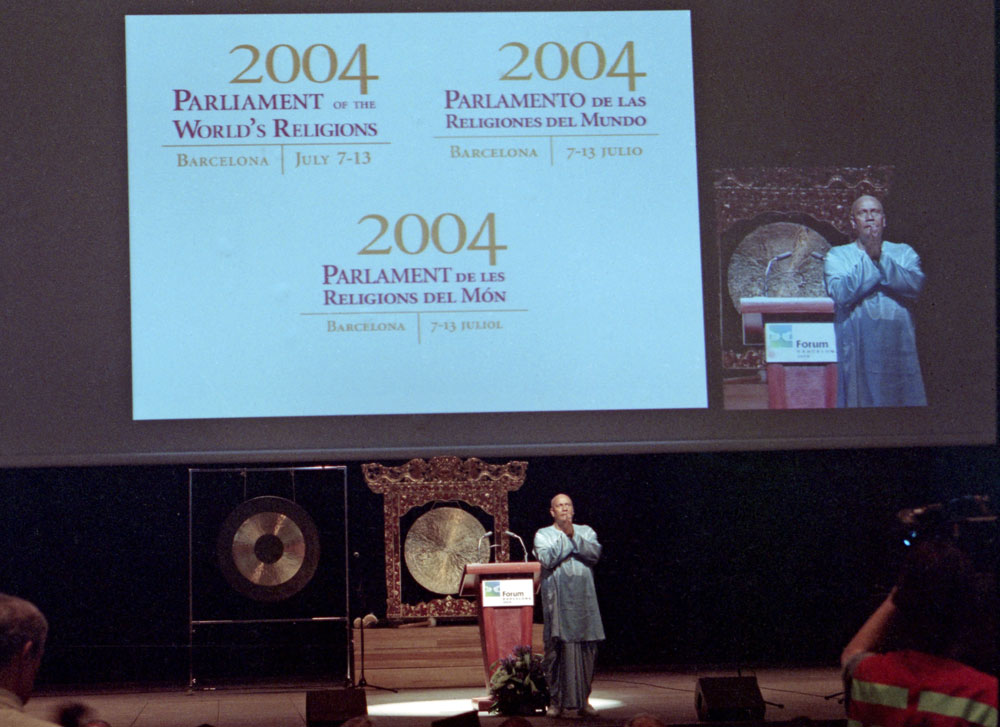
During my opening meditation I am praying for the oneness of all religions.
Sri Chinmoy 2
Photos: Kautuhalam, Toronto, Canada.
- 1. Sri Chinmoy, Earth's Cry Meets Heaven's Smile, Part 2, New York: Agni Press, 1974.
- 2. Sri Chinmoy, I bow to the soul of the Parliament of Religions, Agni Press, 2004
Sri Chinmoy's Jharna Kala Art
Today, November 19, marks the 44th anniversary of Sri Chinmoy's bgain painting his Jharna-Kala artworks. Jharna-Kala, in Sri Chinmoy's Bengali mother tongue, means 'fountain-art' - art springing forth from an inner source of creativity and spontaneity.
 As many observers have commented, the art of Sri Chinmoy expresses a great freedom and joy of movement, unencumbered by the confines of artistic trends or mental concepts.
As many observers have commented, the art of Sri Chinmoy expresses a great freedom and joy of movement, unencumbered by the confines of artistic trends or mental concepts.

Sri Chinmoy begain his painting odyssey in 1974, with a drawing of a simple rose while staying in Ottawa. Up until that date, Sri Chinmoy said he had never felt any particular inclination to paint, but after receiving an inner inspiration from his Inner Pilot, he sought to give expression to this inner direction. In addition, Sri Chinmoy never received any formal training - his artistic endeavours came naturally from his own inner meditation and prayer. Explaining his approach to painting, Sri Chinmoy said:
“I try to make my heart a receptive instrument so that God, the Supreme Artist, can paint in and through me.”
Sri Chinmoy 1
From these humble beginnings, Sri Chinmoy soon became a prolific artist, painting countless abstract acrylics - in the first year alone, he created over 100,000 paintings. Talking about the prolific output, Sri Chinmoy explained:
“It is a continuous, spontaneous flow. Without any obstruction. It comes from within. Anything that comes from the very depths of our heart will have no obstruction on the way. But if it comes from the mind or the vital, there will always be some obstructions, for the capacity of the mind is very, very limited, whereas the capacity of the heart is unlimited, precisely because it is in tune with the soul... If we go beyond the mind we create infinitely more beautiful things.”
Sri Chinmoy 2
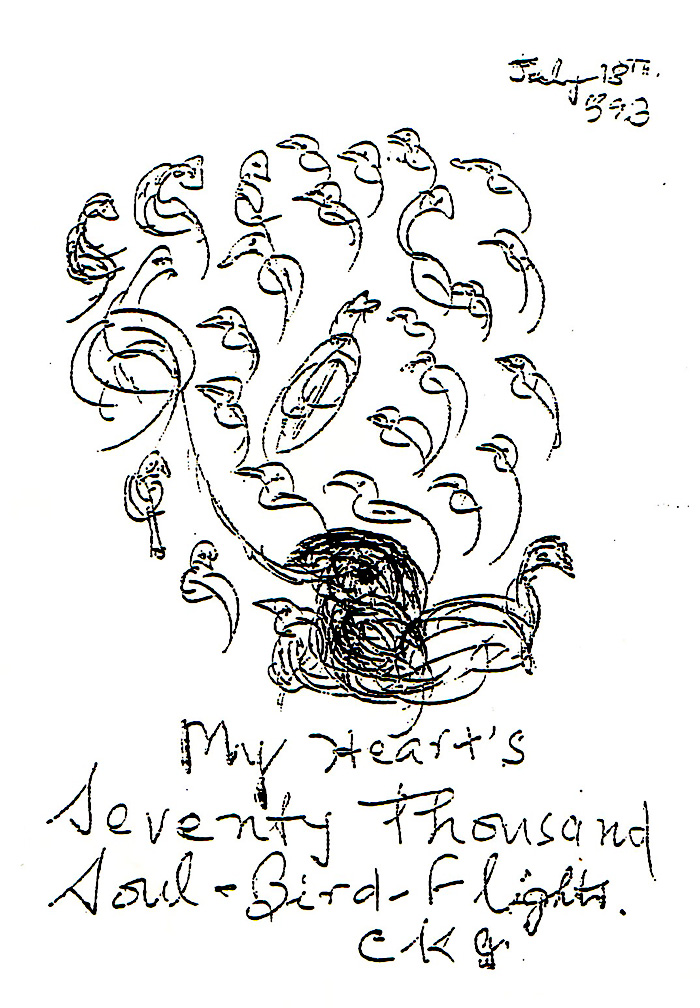
In 1991, Sri Chinmoy's art took a new direction when he began spontaneously drawing birds. He gave this project the name Dream-Freedom-Peace-Birds, and also often referred to these effortless, free-form creations as Soul-Birds. In total, Sri Chinmoy drew 15 million of these unique birds.
“These birds represent unity in multiplicity. Here we have 70,000 birds. Each bird is different, but when you look at them, you feel unity. As soon as we think of the bird-consciousness, it is one. The bird-consciousness represents the consciousness of our soul’s inner freedom.”
Sri Chinmoy 3
Over the years, Sri Chinmoy's paintings and drawings has been exhibited in galleries around the world, such as the Carrousel du Louvre in Paris, the United Nations building in New York and the national parliaments of Australia, Ukraine and New Zealand.
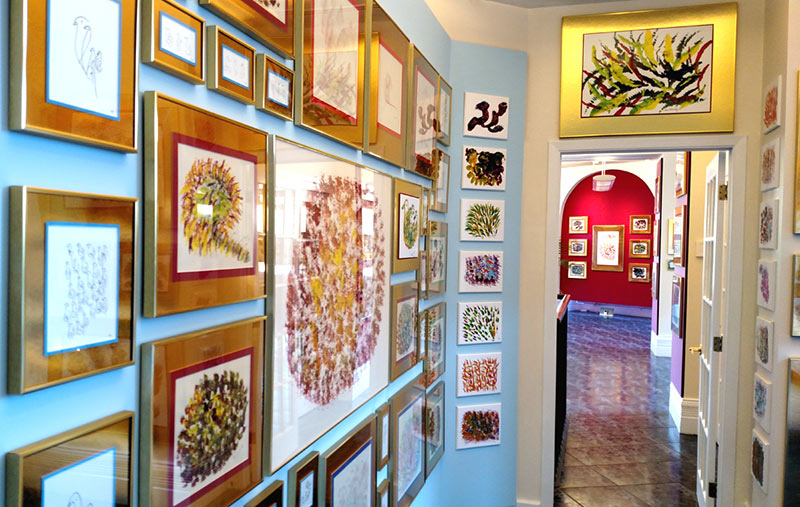
“These are among the most beautiful and stunning paintings I have ever seen. I see in Sri Chinmoy's art the joy of creating beauty. His art is the classic example that creating not only is joy, it should be joy. Through his art he takes his joy and shares it with others.”
Hans Janitschek
Former president, United Nations Society of Writers
Video: Sri Chinmoy talks about his art
Related
- Sri Chinmoy Art at Sri Chinmoy Centre
- Sri Chinmoy Art
- 1. Sri Chinmoy, Sri Chinmoy answers, part 3, Agni Press. 1994.
- 2. Sri Chinmoy, [unofficial transcript TV interview]
- 3. Sri Chinmoy, Sri Chinmoy Answers, part 36, Agni Press, 2004.
Joy Days around the world
Sri Chinmoy encouraged us to come together every so often for Joy Days - spiritual gatherings that contain plenty of meditation, music and spiritual activities, but also games, the company of spiritual friends and a definite emphasis on happiness.
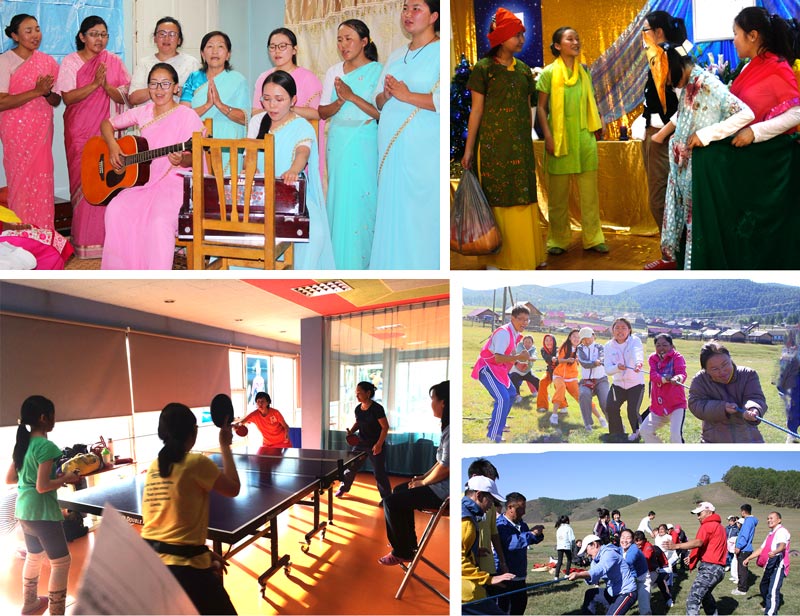
These Joy Days could be as small as a few friends meeting together for an outing, or much larger meetings lasting a few days with several Centres or several countries meeting together.
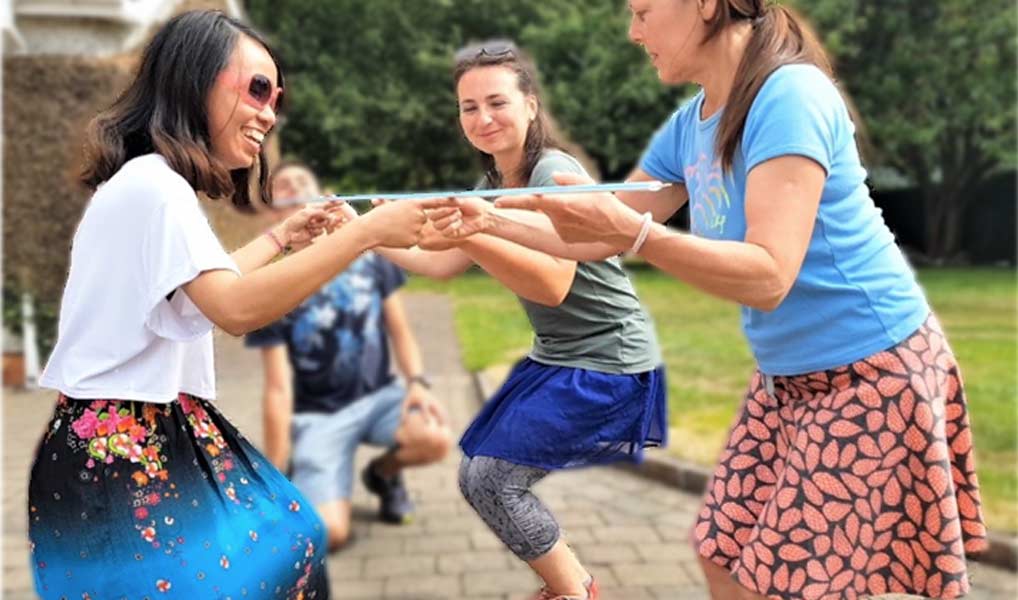
The largest Joy Days take place in Europe and Russia, often with over 700 students of Sri Chinmoy from many different countries taking part. In Europe, the Joy Days usually take place over a weekend, and is quite an organisational feat, with students from many countries giving soulful singing and instrumental performances, as well as sweet and funny plays and humourous sketches. On the Sunday morning, there is usually a group meditation at six o'clock in the morning, followed by a fun two-mile race - Sri Chinmoy loved running, and felt that the outer running and the inner running (i.e. meditation) complemented each other very nicely.


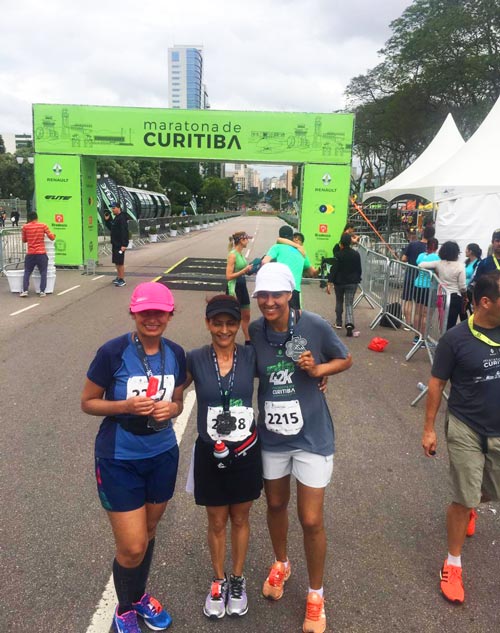
Sri Chinmoy believed that happiness and spiritual progress should go hand in hand:
If you are happy, it will help you to a great extent. If you are unhappy, you won't make any progress at all. On the contrary, you will be marching backwards. Real outer happiness is not self-deception. It does not come from wasting time and indulging in pleasure-life. Real outer happiness is something totally different. It comes from inner joy and inner satisfaction.
Sri Chinmoy 1
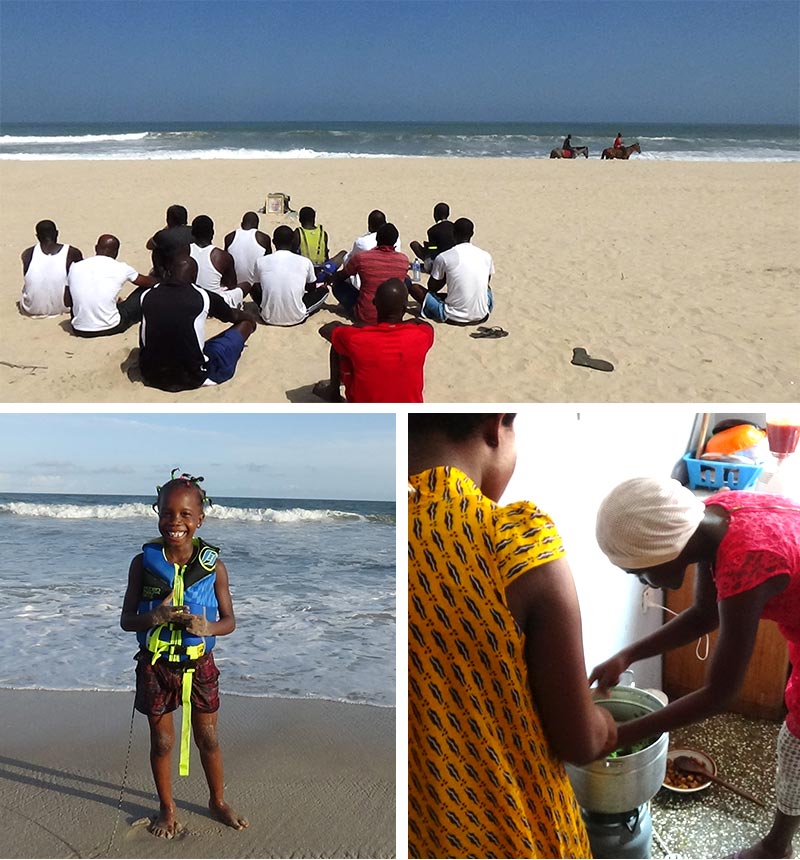
As well as Joy Days, Sri Chinmoy's students often meet together outside of our regular meditation for more formal occasions, for example to mark our teacher's birthday, or the anniversary of his passing on October 11, 2007.

- 1. Sri Chinmoy, The giver and the receiver, Agni Press, 1987
Completion of 2018 Peace Run
Recently, the Sri Chinmoy Oneness-Home Peace Run completed its journey for 2018. The European Peace Run began back in Sofia Bulgaria in February. Not even heavy snowfalls could dampen the enthusiasm of those who set off on their 24,000km journey. Between March and October, the team of volunteers covered over 24,000km. A distance which included visiting 40 different European countries.
During the months on the road, the team of runners got to meet a cross-section of society - from schoolchildren to leading government officials. Whoever they met, they shared a simple message of peace and harmony and invited people to participate with their own contribution to creating a better world.
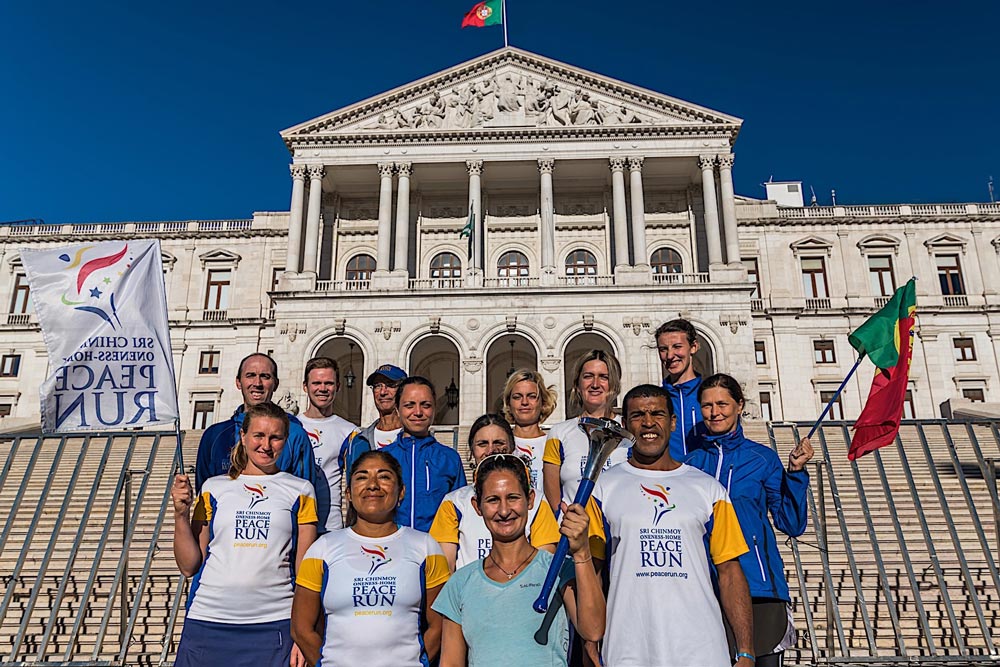
During the closing week in Portugal, the team received a fitting send-off from enthusiastic locals in Lisbon.
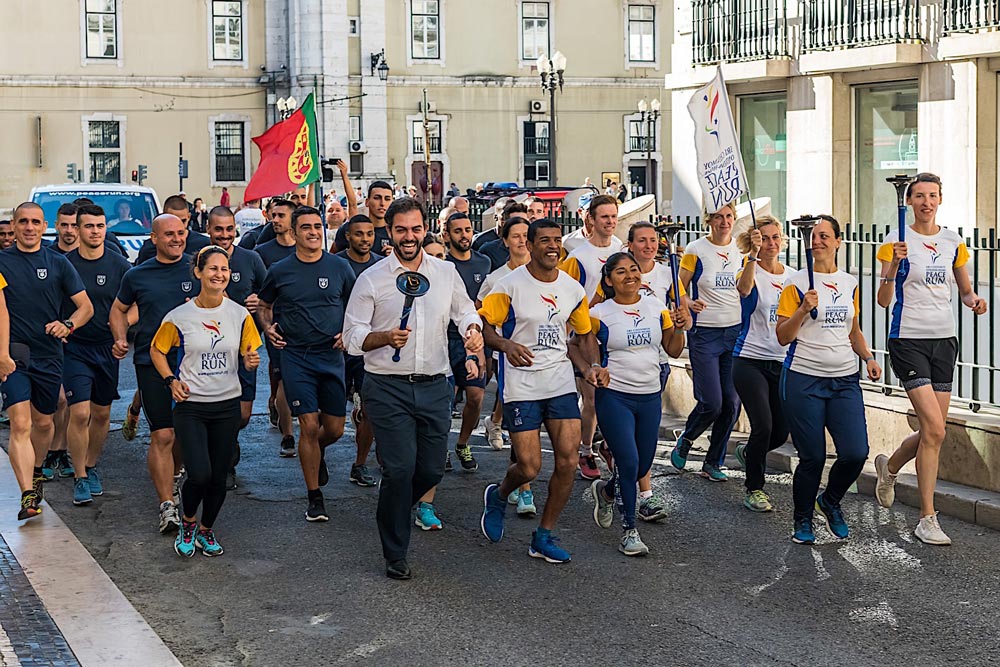
In addition to the European section of the Peace Run, there have also been Peace Runs in all the major continents including Asia, Africa, Australasia and America. Each team contributing to a global effort to share the idea of a oneness-world.
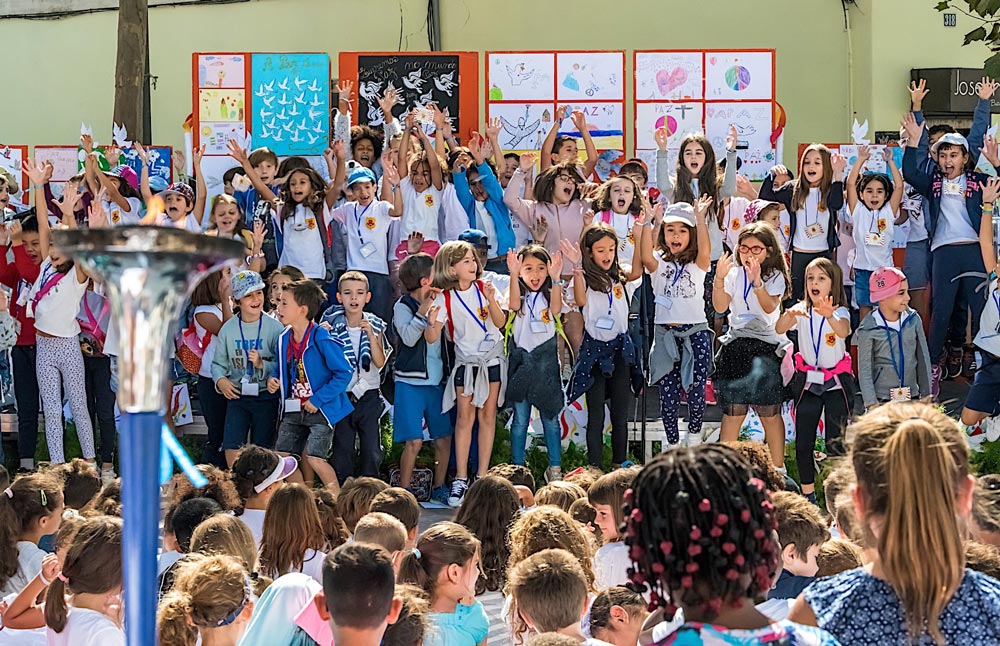
"Today’s chaotic world cannot forever remain chaotic. World harmony, world peace: these are not mere dictionary words. These are the realities, divine and supreme realities. For all of us who are aspiring to become good citizens of the world, our Harmony Run is a supremely important inspiration to us all."
- Sri Chinmoy, June 2005
The Experience of being on the Peace Run
Nikolaus Drekonja was on the whole of the North American Peace Run travelling across the US and Canada. The several months of being out on the road was a life-affirming and life-changing experience. In this short video, Nikolaus shares some of the experiences of being on the Run.
Related
What Sri Chinmoy's Canadian students have done this year....
Sri Chinmoy sometimes described his spiritual path as having two wings. The first wing is aspiration - drawing closer to God through meditation, prayer and other spiritual disciplines. The other wing Sri Chinmoy called manifestation - connecting with the Universal Consciousness through sharing peace, joy and love with the world.
 Purnakama Rajna, a grade school teacher and student of Sri Chinmoy from Winnipeg, reports on some of the many projects Sri Chinmoy's Canadian students worked on this year:
Purnakama Rajna, a grade school teacher and student of Sri Chinmoy from Winnipeg, reports on some of the many projects Sri Chinmoy's Canadian students worked on this year:
Despite the vastness of our beautiful country, and often long distances between our Sri Chinmoy Centres, Canada’s oneness-heart has come together to engage in many different types of manifestation recently.
Find out more: Running for Peace • Athletic events • Celebrating UN Peace Day • Concerts of meditation music • Meditation classes
Running for Peace
The largest and most recent project was the Sri Chinmoy Oneness-Home Peace Run, a bi-annual torch relay that finds runners from the Sri Chinmoy centers worldwide lacing up and hitting the open road. As they carry a flaming Peace Torch across the miles, they also meet with people in the communities that they run through and deliver a simple message: Peace begins with me.
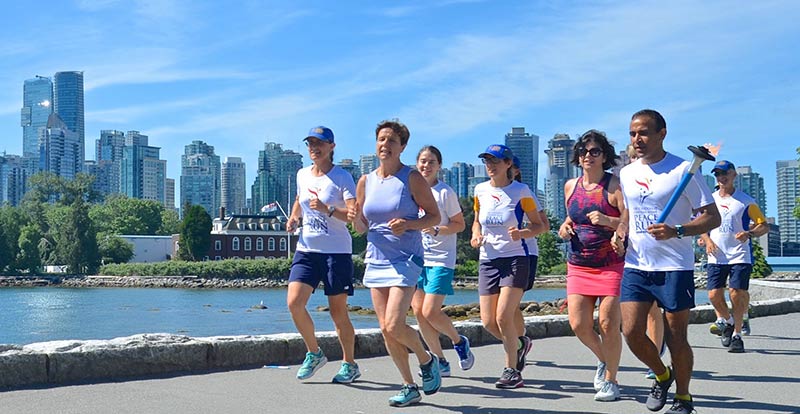
The people that they meet with also get a chance to hold the Peace Torch and make their own silent wish for peace.
This year the North American leg of the Peace Run visited Canada, the USA and Mexico. The Canadian part of the North American Peace Run did not cover all of Canada, but it did cover a large portion. It started on the west coast in June when the Peace Run team visited and had many wonderful events in Victoria and Vancouver, British Columbia. The largest event that the Peace Run was involved in there was called Hands Across the Border, which took place at Peace Arch Park at the border between British Columbia and Washington. It was an event organized by the Boy Scouts and Girl Scouts, and it saw hundreds of children from both Canada and the United States meeting with the Peace Run team, making their own paper torches, and sharing their wishes for peace.
After dipping down into the United States following the west coast visit, the team came back into Canada around Niagara Falls Ontario, and then travelled all the way to Halifax, Nova Scotia stopping at many towns and cities along the way over a three-week period. The team was very fortunate to be hosted by the Sri Chinmoy centers in Toronto, Kingston, Ottawa, Montreal, and Halifax, on their stay in those cities.
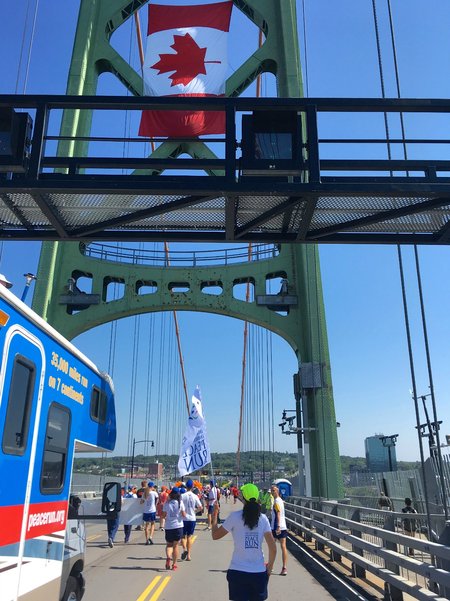
Just like Canada’s many waterways, the Peace Run was like a river flowing with amazing events in each community, from meeting hundreds of children at day camps, planting a peace tree, meeting with city, community and religious leaders, and the grand finale, marching in a parade in Halifax with 40,000 people lining the streets as we marched by with the Peace Run banner.
Being lucky enough to have been one of the participants on the Peace Run, I can say that it was one of the most light filled, joy filled experiences I have ever had.
The Peace Run team did not make it to Winnipeg this year, but the center there came together and organized an event, which saw many children run with the Peace Torch to City Hall to meet the mayor. Mayor Bowman graciously welcomed the children and the local team and gave a very inspiring talk about peace and oneness.
Running events
Running is a very important part of Sri Chinmoy’s path, and while the Peace Run was happening in July, another running manifestation was happening in Ottawa at the same time.
On July 28th, the 37th annual 24 hour race took place in Ottawa. Also included in this was a 12 hour and a 6 hour race. This is one of many ultra-running races that are organized by Sri Chinmoy centers around the world and open to any runners in the community who have a passion for running. Started in 1981, the race is the longest-running 24 hour race in the world and also the world's oldest timed ultra race.

Putting on a race of this caliber is no small feat, but this year it was made even more challenging as many of the helpers from the nearby centers who usually volunteer were busy with the Peace Run, and so they had to make do with far fewer volunteers than they are used to. Despite this disadvantage, the Ottawa center rallied together and put on a fantastic race once again.
Celebrating the UN Day of Peace
September 21st was the United Nations Day of Peace. As Sri Chinmoy used to lead twice weekly meditations at the United Nations, many meditation centers around the world like to mark this day with some type of special event.
In Rome they had an exhibition of children’s artwork at the Colisseum to celebrate and commemorate this day. The artwork came from children from all over the world who expressed their own wishes for peace through their art pieces. Hundreds of children from Canada from four different provinces also sent their art to be shown at this exhibition. Many of the summer day camps that were visited on the Peace Run embraced the project and spoke to the children about the motto of the Peace Run - "Peace begins with me".

Their artwork was one powerful way to express that motto and to show the world the true meaning of peace through the heart of a child.
Also on September 21st, several disciples from the Ottawa center took the Peace Torch to Parliament Hill. No matter what time of year, the Canadian Parliament is host to many tourists, so on September 21st many of those tourists from across the country and around the world had the wonderful opportunity to hold the Peace torch and make their own silent wish for peace.
Concerts of meditative music
Sri Chinmoy was a prolific songwriter, so it comes as no surprise that music plays a very important role in our meditation centers. In Canada we have many musicians and singers who perform at many different events around the world.
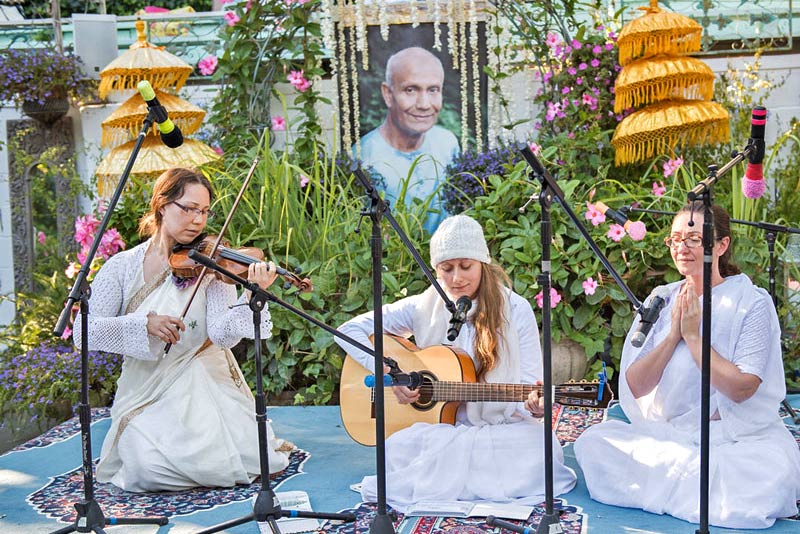
Sangit Surabhi, a group of female musicians and singers recently performed in Montenegro on a special Christmas trip attended by disciples, as well as in New York in June and August for a special gathering of disciples there. They also regularly perform for meditation classes in Ottawa and Montreal.
Audio: Sangit Surabhi sing a song composed by Sri Chinmoy about the Christ - taken from a performance on Christmas Day, Montenegro 2017.
 Pavaka from Montreal is our wandering troubadour who performs regularly with a concert series called Songs of the Soul, which features musicians and singers from around the world. The concerts are offered free of charge to the public and showcase Sri Chinmoy’s music as interpreted by different disciple musical groups. Most recently Pavaka attended a very successful concert tour in Brazil where he offered his talents on guitar, vocals, and bass.
Pavaka from Montreal is our wandering troubadour who performs regularly with a concert series called Songs of the Soul, which features musicians and singers from around the world. The concerts are offered free of charge to the public and showcase Sri Chinmoy’s music as interpreted by different disciple musical groups. Most recently Pavaka attended a very successful concert tour in Brazil where he offered his talents on guitar, vocals, and bass.
Audio: A recording of Sri Chinmoy's music by Pavaka's group
Meditation classes
And of course, as with Sri Chinmoy centers around the world, offering free meditation classes is one of the most important and constantly ongoing manifestations that we do. Every center puts on their own classes, but sometimes we are fortunate enough to have guest speakers come in from centers from around the globe. In September, the Ottawa and Montreal centers welcomed Prachar from Australia who gave a series of dynamic talks to seekers about meditation.
As well as hosting guest class-givers, we also sometimes send class-givers abroad to give a fresh perspective on meditation classes. Shishir from Winnipeg will be heading to the Ukraine and parts of Europe in early 2019 for a four-week class giving tour. His lively and friendly approach is always well received, and he has become quite a popular guest speaker.
Utsahi from Ottawa, Canada also travelled to give classes in 3 cities in France this year. Ascharjya from France had this to say:
Utsahi, a student of Sri Chinmoy's since 1987, has been publishing articles and books since he accepted a professor’s position in the mid-1980's. He also created and is still directing a scientific journal. He has lectured on social sciences around the world, and participated frequently in the Parliament of the World's Religions, notably in Barcelona, Salt Lake City, Melbourne and this year in Canada.
Utsahi is also the owner of a small gift shop, The Garden of Light, whose name was given by Sri Chinmoy when it first opened in 1999. He is a lover of Nepal, where he regularly goes shopping and offers meditation workshops, and from where he brings back his famous singing bowls, sometimes very old and expensive! It is a pleasure for him to make them vibrate and sing during his lectures and meditation workshops.
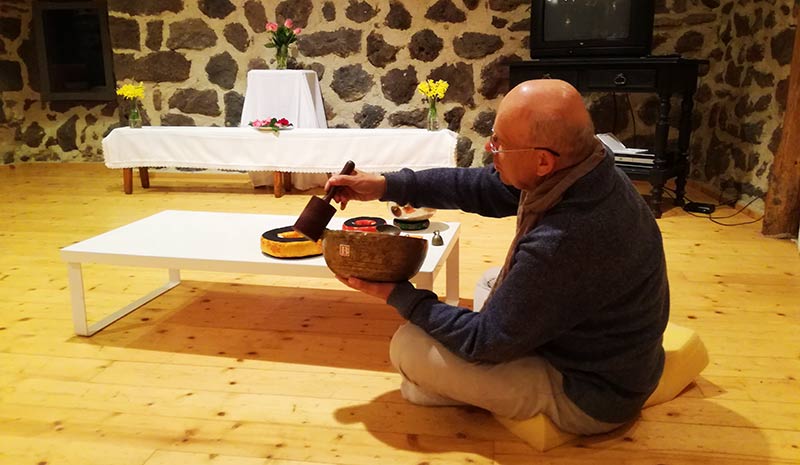
During his meditation workshops, he also draws from his experience as a father and from his profession, which puts him in contact with people who, by their culture, their education and/or their life experience, are victims of marginalization and social exclusion. His classes are full of anecdotes, tinged with humor and enhanced by his charming Canadian accent. The classes in France were very successful, with 67 people attending in Nancy, a record for this city. Utsahi also offered three classes in Paris and then moved on to Montpellier for a final series of three lecture in France.
Find out more:
- Read daily news reports from the Canadian Peace Run
- 24 hour race website
- Free meditation classes and concerts in Canada
Janaka receives the Order of the Rising Sun
This year, Janaka Alan Spence from the Edinburgh Sri Chinmoy Centre received the Order of the Rising Sun, an honour bestowed by the Japanese government in the name of the Emperor. Janaka, who is one of Scotland’s best-loved poets and authors, received the award for his books of haiku poetry and his novels set in Japan, and for promoting Scottish-Japanese friendship and cultural exchange over many years.
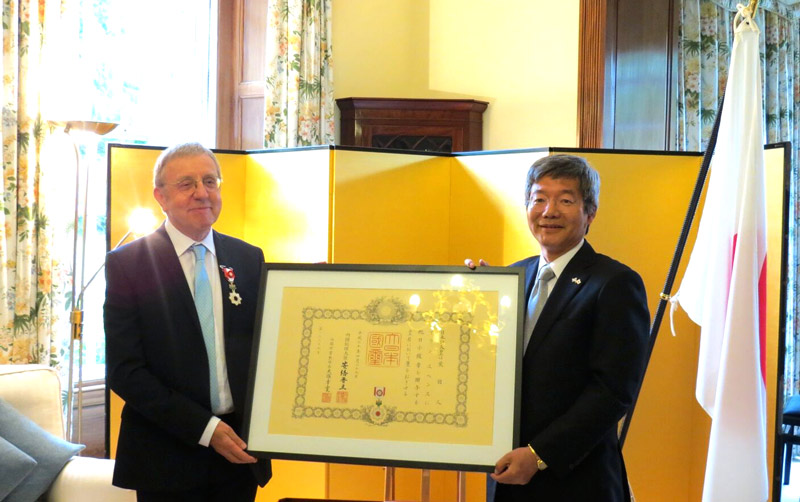
Created in 1875, the Order of the Rising Sun is Japan’s third highest honour, and is (with rare exceptions) the highest that can be given to non-royalty or non-politicians. The award was presented by the Japanese Consul-General, Daisuke Matsunaga, in a special ceremony at his residence in Edinburgh.
Janaka published his first book - a collection of short stories called Its colours they are fine - over 40 years ago. His first book of poetry, Glasgow Zen, was published in 1990, and was followed by The Clear Light and Seasons of the Heart.
I sit inside
the compassionate Buddha
who sits inside
this world of things
which sits inside
the universe
which sits inside
the great void
which sits inside
my heart.from 'Glasgow Zen'

crocuses
where last week
the snow lay thick
into the sea I launch
a piece of driftwood –
with great ceremony!
that old/new
smell of fresh
cut grass
the flowering plant nods
acknowledging
my gaze
Haiku poems from 'Seasons of the Heart'
 Janaka has also written two novels set in Japan and inspired by Japanese historical events. The first novel, The Pure Land, was published in 2006. Night Boat was published in 2014 and retells the life of the Japanese Zen monk Hakuin.
Janaka has also written two novels set in Japan and inspired by Japanese historical events. The first novel, The Pure Land, was published in 2006. Night Boat was published in 2014 and retells the life of the Japanese Zen monk Hakuin.
The presentation ceremony was attended by a few dignitaries and friends from the arts, along with friends from the Sri Chinmoy Centre. Janaka sang one of the many songs that Sri Chinmoy wrote in honour of Japan, in both English and in Japanese:

By way of thanks, Janaka later sent this poem by Sri Chinmoy to the Consul-General:
A RISING INNER SUN
If you love knowledge-light
And if you love and need
Wisdom-delight,
Then every day,
Just for a few fleeting seconds,
Dive deep within.
You are bound to see
A rising inner sun
With ever-increasing golden rays.Sri Chinmoy
Related articles and videos by Janaka:
- Reflections on meditation - BBC
- Video: Time for Reflection at the Scottish Parliament, given by Janaka
- Give Peace a Chance - the Scotsman
The Oneness-Fountain-Heart restaurant celebrates its 20th birthday
The Oneness-Fountain-Heart, a vegetarian restaurant in New York run by Sri Chinmoy's students, celebrates its 20th anniversary this year. The restaurant is located in the Flushing area of Queens and over the past twenty years has welcomed locals and faraway visitors alike to enjoy its peaceful ambience and tasty food.
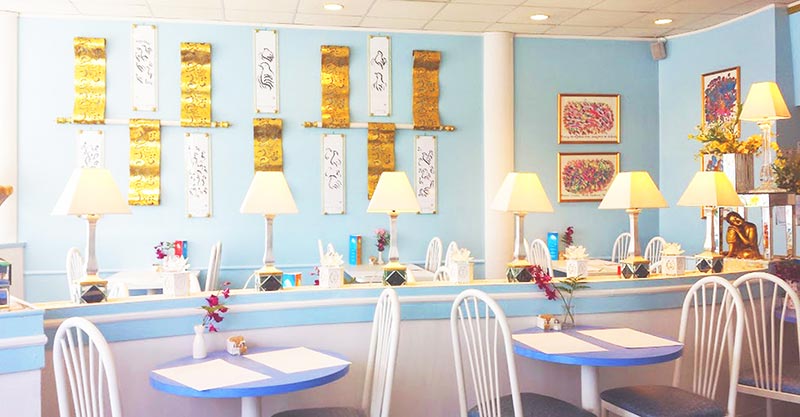
The restaurant was founded in March 1998 by Sri Chinmoy's students with his guidance and encouragement; he offered advice about creating a welcoming atmosphere that was light, peaceful and with a delicate touch. The restaurant aims to serve an international cuisine through natural ingredients and is dedicated to conscious living and healthy eating.
The design of the restaurant is inspired by the Japanese qualities of simplicity, subtlety and beauty while also having a sense of cosmopolitan grandeur; this international feeling is also reflected in the range of dishes. The restaurant frequently hosts themed nights, featuring concerts of meditative music and talks by special guests on subjects ranging from Thomas Jefferson to the 16th century Moghul Emperor Akbar.
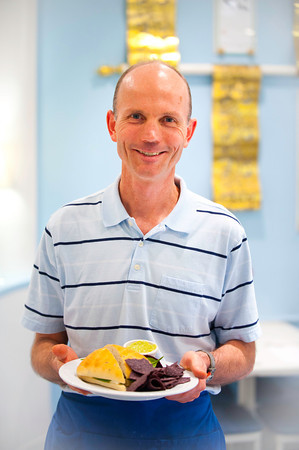
The dedicated staff at The Oneness-Fountain-Heart state it is hard work, but also very rewarding due to the positive responses from the customers, who often say this is their favourite restaurant. Shashanka, who took over ownership of the restaurant in 2008, says that Sri Chinmoy's advice for running a successful restaurant has proven invaluable - maintaining a vibration of cleanliness and purity, plus a feeling of concern and warmth to all the customers who come to the restaurant.
As Sri Chinmoy said at the opening of the restaurant: "As much as possible, make the customers feel that they are guests — they have not come just to make a business transaction. Try to make them feel at home.”
Related
- Enterprises run by Sri Chinmoy's students around the world
- First steps: Shashanka talks about how he came to Sri Chinmoy's path
New Guinness Record for Sri Chinmoy's birthday
In honour of Sri Chinmoy's 87th Birthday on August 27th, a team of volunteers led by Ashrita Furman created a new Guinness World Record for the largest logo created using tennis balls.

The composition of tennis balls shows the logo of the Sri Chinmoy Oneness-Home Peace Run, which was founded by Sri Chinmoy in 1987 and has since grown to become the world's longest relay run for peace - traversing 146 nations and passing through a route of over 600,000 km.
The project was co-ordinated by Ashrita Furman, who for over two decades has been the holder of the most Guinness World records, with over 200 to his credit.
“This tennis ball logo expresses our sincere wish for world peace and is our modest offering of joy to the world. With thousands of tennis balls we want to honour the memory of Sri Chinmoy, who was the founder of the Peace Run and an avid tennis player.”
Ashrita Furman
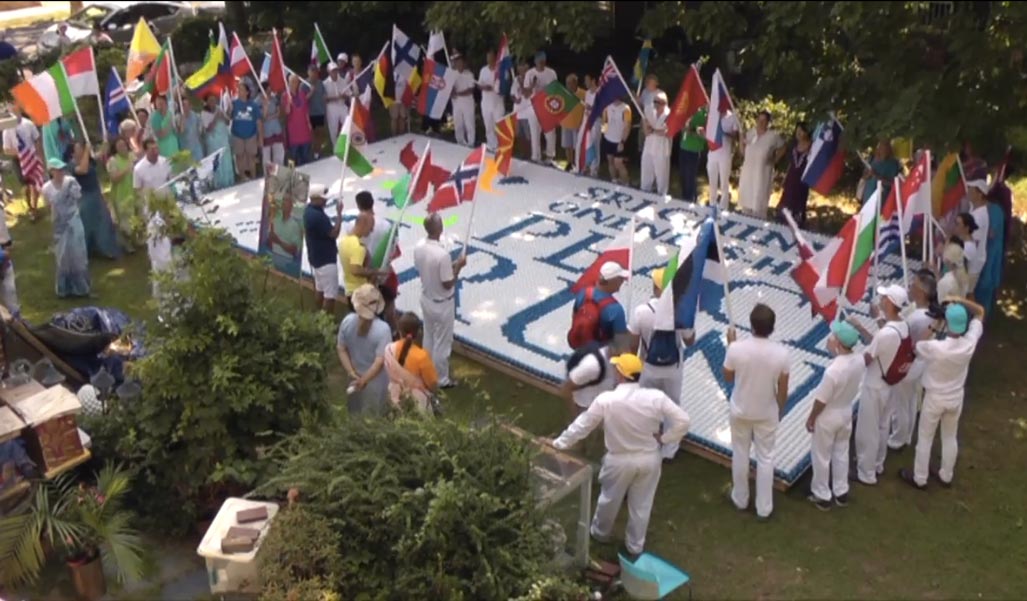
Ashrita also talked about how the driving force behind these kinds of projects is Sri Chinmoy's philosophy of self-transcendence - the goal of achieving more and bettering our previous efforts.
“We are constantly striving to push ourselves to a higher and higher level. Like to not listen to our mind and doubts that tells us: We can't do things. And try to go within our spiritual heart and draw on that power, that strength that we all have and constantly pushing higher and higher and further and further. And so it is in the spirit of self-transcendence that I break records personally, that many of my friends swim the English Channel or run ultra marathons, run the 3100 Mile Race. This is the same principle. We try to, you know, as a team to do something greater than we did before.”
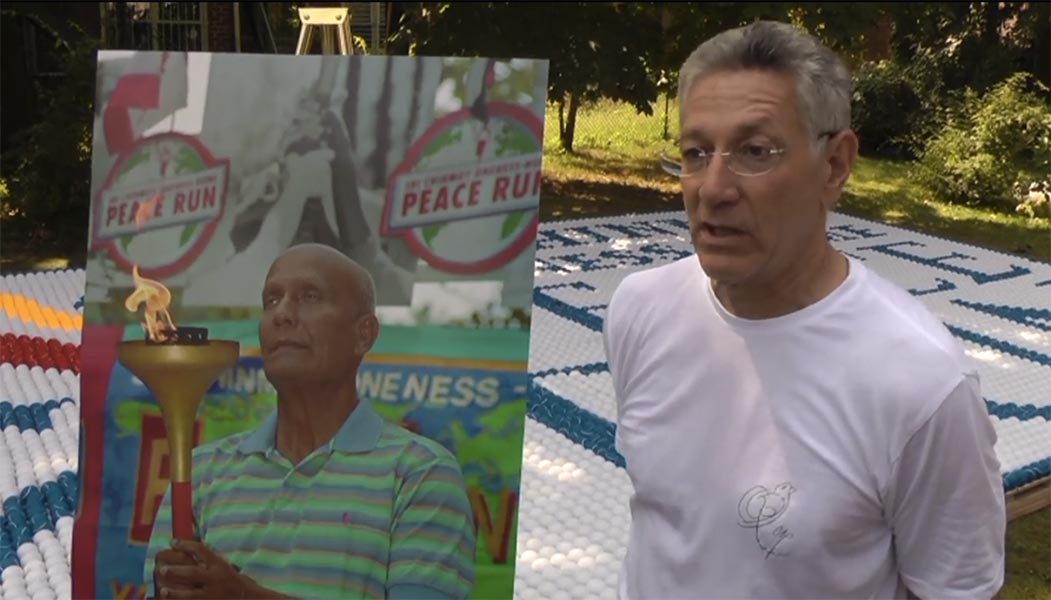
To complete the record took seven days of hard work. It also required ingenuity and a considerable degree of trial and error to make a logo from large tennis balls. Artist Papaha Gosline, who oversaw the design, said:
“When you are tacking tennis balls to represent a piece of art, it is a very low resolution. And so you have to kind of figure out how do you make an “e” with only 70 or 200 balls.”
The design spreads over a distance of 53.41 square meters and is made up of 12,393 tennis balls in five different colours.
Sri Chinmoy passed away in 2007, but his students from around the world still come to New York to celebrate his birthday with meditations and other events, just as they did when Sri Chinmoy was with us. Some of the other events included Songs of the Soul concerts, running races, music performances and a Poetry Festival.
New film - 3100: Run and Become
A new film 3100: Run and Become offers a powerful glimpse into the world of ultradistance running, including a special look at the Sri Chinmoy Self-Transcendence 3100 Mile Race, the longest certified race in the world which was founded by Sri Chinmoy in 1997. A project that took over 3 years to complete, the film is now being shown in screens across the United States.
The film follows the fortunes of two runners in the 3100 Mile race - Finnish postman, 14 time finisher and record holder Ashprihanal Aalto, and first-time competitor and Austrian cellist Shamita Achenbach-Koenig. Through their eyes, the viewer is brought into this unique world of self-transcendence, outer challenge and inner fulfilment. As the course director of the 3100 Mile Race states in the film, it is impossible to enter this race without changing for the better.
Interspersed with the 3100, the film also explores the spiritual significance of running from the perspective of three very different cultures. It includes the Gaolo-San bushmen in Botswana, the legendary Japanese gyoman-san running monks of Mt. Hiei Japan, and Navajo runners in the deserts of Arizona.
Sri Chinmoy believed that distance running could enable a real inner and outer transformation or as he terms it 'self-transcendence.' The 3100 Mile race has been described as the 'Mount Everest of ultra-running' - which is fitting given that in the 20 years to the end of 2016 only 37 different runners had completed the distance. Directed by Sanjay Rawal, the film focuses on the 2016 edition of the race, where record temperatures made the event even more challenging and just five of the twelve runners completed the event. (More about the 2016 race on the race website »)
Whilst the statistics of the race are mind-boggling, the film gives an insight into the very human realities and aspirations of the competitors. In particular, the film picks up on the inner spiritual dimension of the runners who need to tap into hidden reserves to both run and meet the realities of the race.
Related
For a full list of cities, and to request a screening in your own city, visit the official film site...
Celebrating Sri Chinmoy's 27,000 Aspiration-Plants poem series
This year marked the 20th anniversary of the completion of Twenty-Seven Thousand Aspiration Plants, the second of Sri Chinmoy’s three epic poetry series. Sri Chinmoy wrote the first poem on July 10, 1983 - just one week after completing the first series, Ten Thousand Flower-Flames - and completed the last poem in the series 15 years later. The series was published in 270 volumes containing 100 poems each.
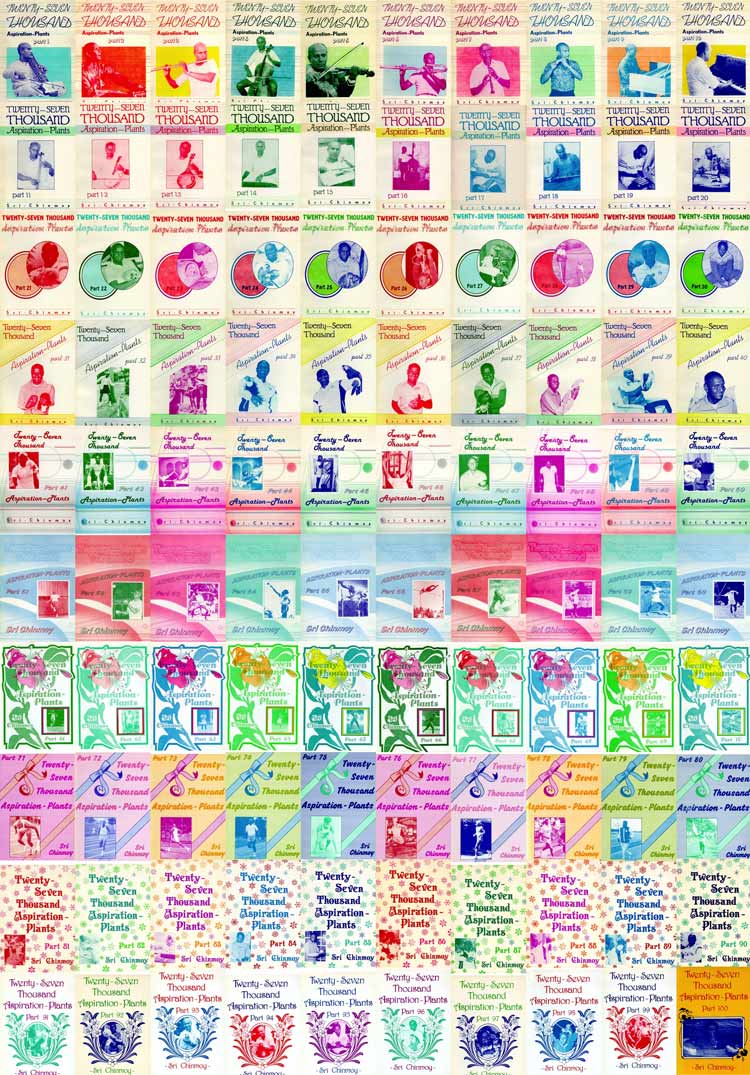
Sri Chinmoy announced his vision of 27,000 poems even before he had completed his Flower-Flames series, during a trip with his students to Japan in December 1982. The first volume was published in time for Sri Chinmoy’s birthday in August 1983, and he gave the book out as a gift to all of his students attending his birthday celebrations, asking them to try to to feel the poems inside their hearts. Sri Chinmoy finished the final poem on 24 January 1998 while on his annual Christmas vacation with his students - at the time they were in Cancun, Mexico. To mark this achievement, he invited his students who were present to form groups to chant the mantra Supreme 27,000 times.

Sri Chinmoy would always find ways to make his students part and parcel of whatever he was doing. and to claim his achievements as their own. At the time, many of his students around the world came up with fun and spontaneous celebrations to mark their teacher’s achievement. For example, in Canada, his students created a huge red and white Canadian flag made from 27,000 snowballs on a prominent hill near the Parliament Buildings. A Reuters cameraman happened to walk by and took a photo of the flag which ended up appearing in newspapers across Canada the next day. In New Zealand, Sri Chinmoy suggested to his students there that they shake 27,000 people’s hands, giving each of these people a card of poems and a sweet. In the words of Jogyata Dallas, one of the organisers: “This unique challenge quite consumed us for some time. We visited school assemblies, announcing a handshaking-record attempt to honour our Guru’s achievement; stood at escalators in shopping malls with a microphone to introduce ourselves, and armed with a hand-held manual counter to accurately record numbers; visited universities and busy streets; toured towns, distributed 27,000 sweets and gave away 27,000 large cards – each carrying an explanation and a sample sprinkling of 27 poems, like this one:”
If you want to remain always happy,
Always perfect and always fulfilled,
Then always keep inside your heart
A pocketful of sweet dreams.
“Everything about this unusual commemoration charmed people a lot, and left 27,000 spirit-awakening, heart-warming mementos with their 27 inspirational poems scattered throughout this peace-hungry world.”

This year, Sri Chinmoy ’s students held various commemorations to mark the 20th anniversary of the poems’ completion in 1998. At the time, many of his students were very involved in proofreading and printing the books, and they vividly recalled what powerful meditative and transformative experiences they had working with such vast numbers of poems.


